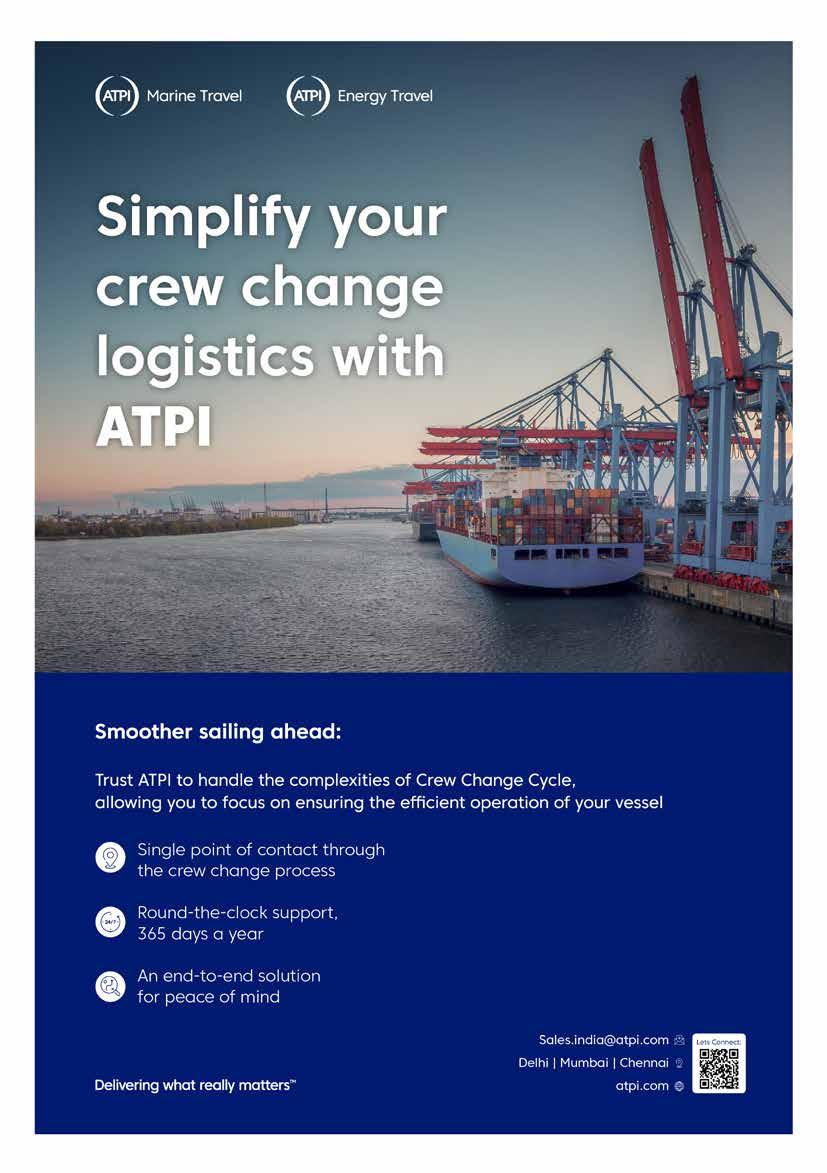MARITIME MATRIX
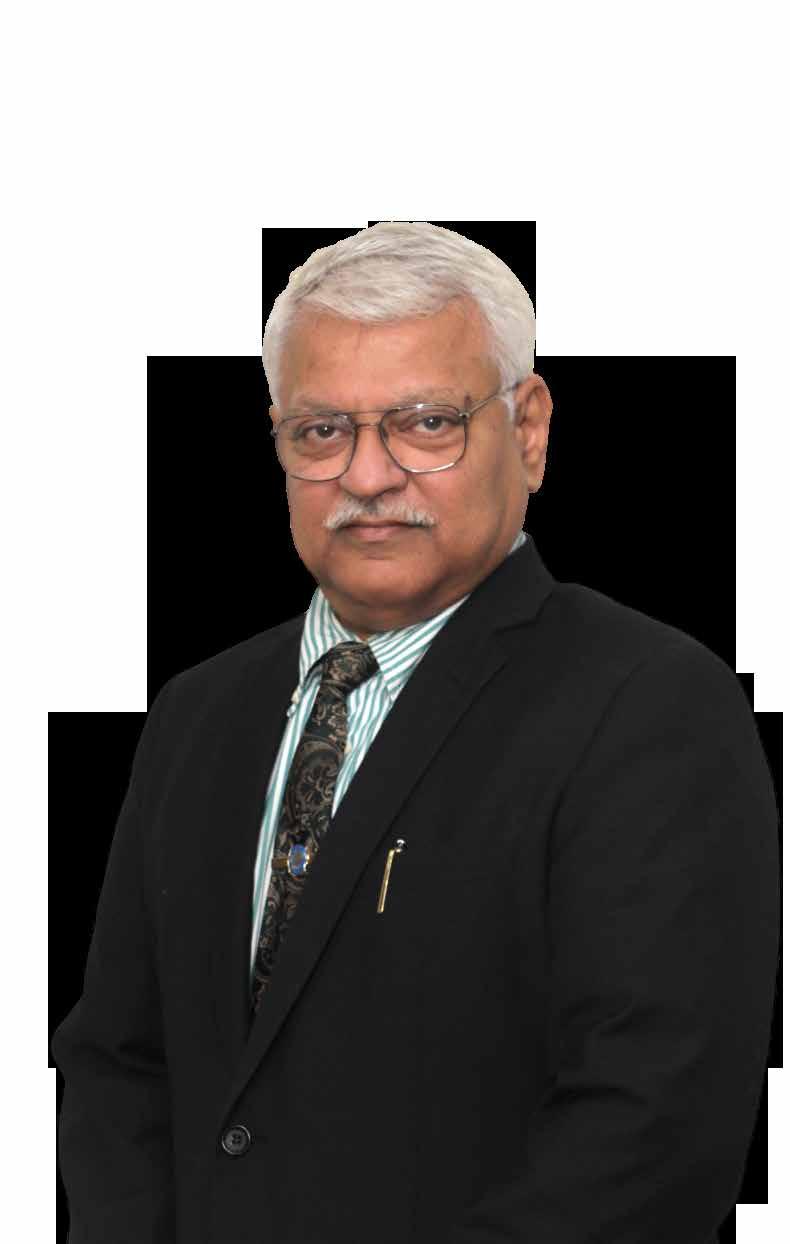

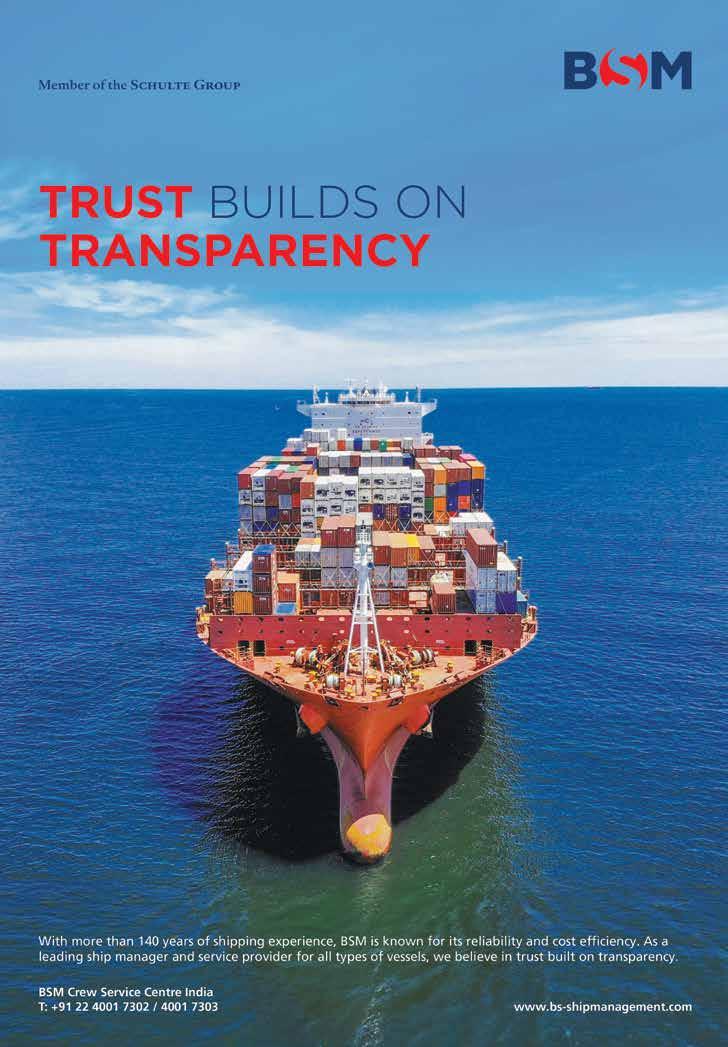
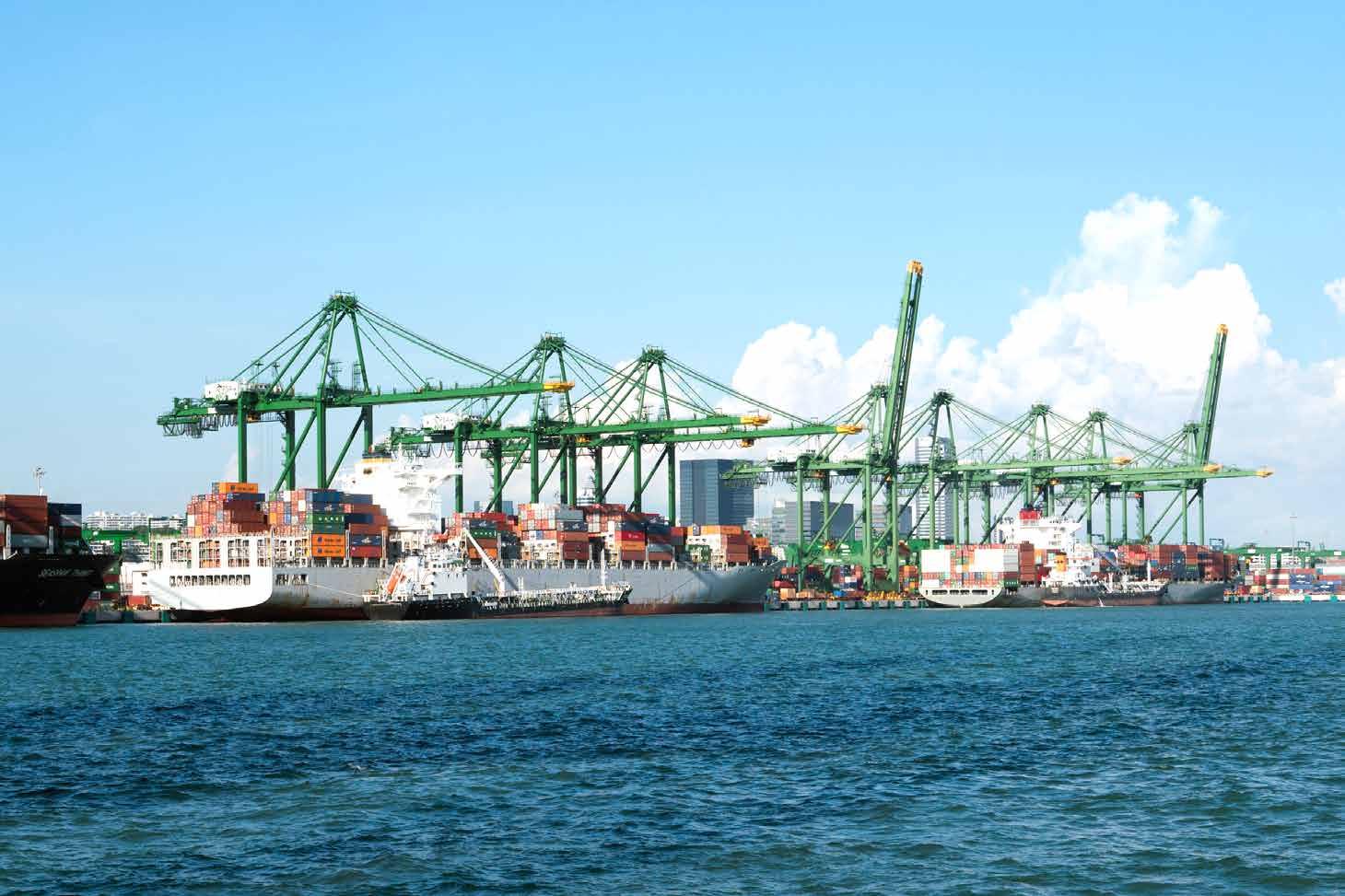







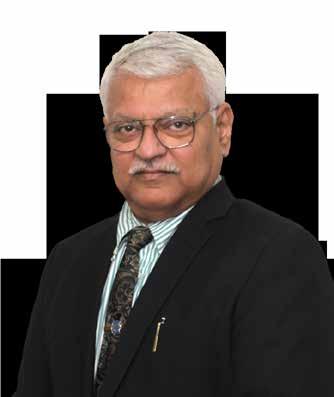
Steering
Shri Sonowal inaugurates India’s First Maritime Simulation Centre at AMET University
Disclaimer
All advertisements in this magazine are placed with no liability accepted by the publisher for the material content therein. No responsibility is accepted by the publisher for omission or error or non-insertion of any advertisements. All advertisements and material in this magazine are subjected to approval by the publisher and are not necessary the opinion of the publisher. No liability is accepted for advertisements that are placed or any information that might be criminally connected. All information is checked to the best of our knowledge and is reliant upon the material submitted not being in contravention of all relevant laws and regulations and within the provisions of the Trade Practices Act.
Reproduction Prohibited
Maritime Matrix Today will not be responsible for the views expressed by contributors in their personal capacity. All rights reserved. Reproduction in part or whole without the permission of the Editor is prohibited.
Readers are recommended
To make appropriate enquiries before sending money, incurring expenses or entering into any commitment in relation to any advertisement published in this publication. Maritime Matrix Today does not vouch for any claims made by the Advertisers of Products and Services. The Printer, Publisher, Editor and Owner of Maritime Matrix Today shall not be held liable for any consequences, in the event such claims are not honoured by the Advertisers. RNI: MAHENG/2013/50159 Published by Marex Media Pvt Ltd C-209, Morya House, New Link Road, Andheri West,
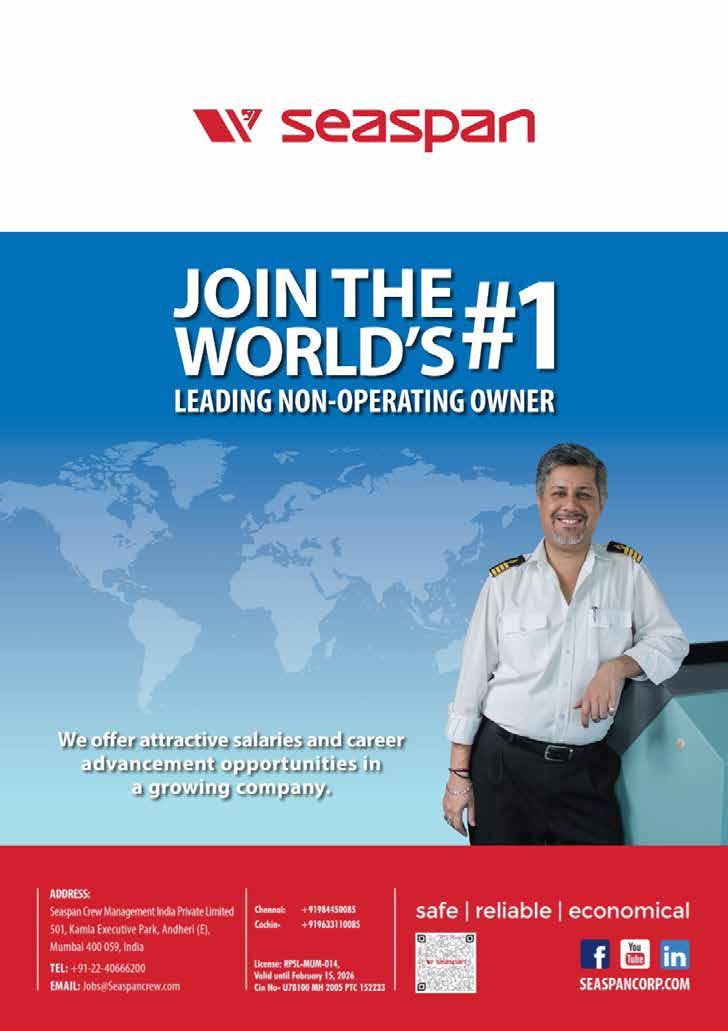
India’s economic acceleration is being driven by strategic infrastructure initiatives, with ‘Make in India’ at the core of strengthening domestic manufacturing and industrial growth. The National Industrial Corridor Development Programme (NICDP) is creating worldclass manufacturing hubs, while PM Gati Shakti enhances multimodal connectivity through data-driven planning. These initiatives are fostering seamless logistics, boosting competitiveness, and positioning India as a global economic powerhouse.
One would agree that while India has been pursuing the infrastructural push with various policy reforms, the ‘Make in India’ has started showing tangible result. India, as a home to one of the world’s fastest-growing economies and a vibrant digital ecosystem, is undergoing a logistics renaissance with the government pushing ahead with the National Logistics Policy (NLP), infrastructure upgrades, and a vision to reduce logistics costs from 14% to around 8% of GDP.
With initiatives like ‘Make in India’ and the ‘PLI’ (Production Linked Incentive) schemes, India is emerging as a global manufacturing hub. This shift has led to an uptick in industrial logistics needs and the third-party logistics (3PLs) are stepping up and are emerging as vital enablers of growth across sectors; from e-commerce to pharmaceuticals to heavy manufacturing offering integrated freight, customs, and warehouse solutions to manufacturers, particularly in automotive, electronics, and pharma sectors.
We all know, the total infrastructure spending has grown exponentially, with budget allocations to the sector rising significantly, supported by both public and private sector contributions.
Strengthening India’s road and maritime infrastructure is central to the Make in India vision, ensuring seamless connectivity for industries and boosting economic growth. Strategic initiatives like Bharatmala and Sagarmala are enhancing freight movement, improving logistics efficiency, and modernising transport networks to support India’s manufacturing and trade ambitions.
Needless to say, India has made rapid strides in infrastructure across sectors, marked by a 60% expansion of the National Highway network and a six-fold increase in metro rail length (from 248 km in 2014 to over 1,000 km by 2025), alongside significant growth in rural roads under PMGSY and digital connectivity. These developments are driving economic growth, generating employment, improving connectivity and efficiency, and enhancing the overall quality of life by providing better access to essential services and opportunities.
However, such rapid expansion is not without challenges. It brings the risk of environmental degradation, unplanned urbanization, resource shortages, and increased pressure on ecosystems and biodiversity. To mitigate these risks, it is imperative that infrastructure growth is guided by sustainable, inclusive, and future-focused urban and industrial planning.
Kamal Chadha Group CEO kamal@marexmedia.com
Shirish Kirtane
HOD Graphics shirish@marexmedia.com
Radhika Vakharia CEO radhika@marexmedia.com
Santosh Nivalkar Sr. Graphic Designer santosh@marexmedia.com
Padmesh Prabhune Editor padmesh@marexmedia.com
Manish Malve
Graphic Designer manish@marexmedia.com
Delphine Estibeiro Editorial Coordinator delphine@marexmedia.com
Bhavna Pimpale Coordinator bhavna@marexmedia.com
Jagdamba Pandey Manager, Business and Promotion jagdamba@marexmedia.com
ClassNK is a major supporter of the Digital Era
On August 1, 2025, ClassNK, a leading classification society, hosted its highly anticipated technical seminar at Hotel Holiday Inn in Chennai. The event was a resounding success, attracting a sizable and engaged audience of over 100 maritime professionals. The attendees, representing prominent ship management companies and other key industry stakeholders, gathered to discuss the latest developments and future trends shaping the maritime sector.
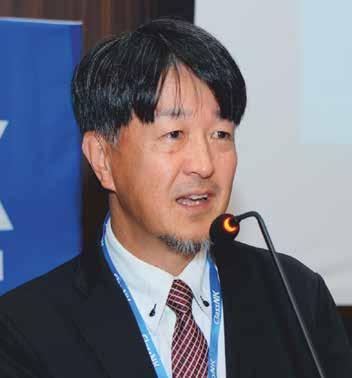
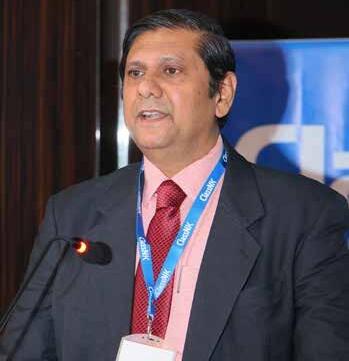
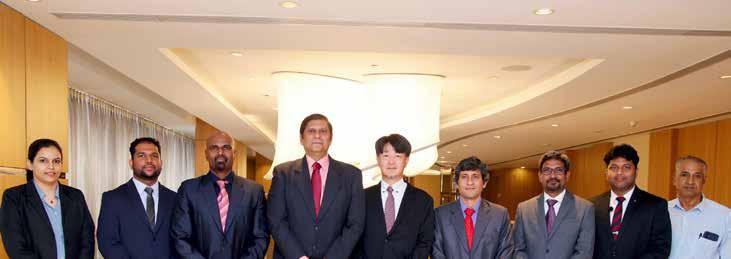
The seminar’s collaborative tone was set from the beginning by Mr. Yochi Iga, Regional Manager, and Mr. Sumithran Sampath, General Manager, who delivered a warm welcome. Their opening remarks emphasized the importance of continuous dialogue and forward-thinking collaboration to navigate the industry’s evolving landscape.
A series of insightful presentations by ClassNK experts formed the core of the seminar. Mr. Siva Sandrani, a ClassNK Surveyor, began by providing a comprehensive update on the latest discussions and regulatory changes at the International Maritime Organization (IMO). His talk covered crucial topics like maritime safety, environmental protection, and the ongoing digital transformation of the industry, giving attendees a clear picture of the global regulatory environment.
Following this, Mr. Sekhar Padala, Manager, took the stage to discuss the increasing adoption of energy-saving technologies on vessels. He highlighted how these sustainable practices are not only crucial for reducing carbon emissions but also for cutting operational costs, a key concern for shipping companies today. His presentation underscored the industry’s shift towards more environmentally responsible and economically viable solutions.
The presentations concluded with Mr. Divyal Komarpant, Surveyor, who shared valuable statistics and insights related to Port State Control (PSC) inspections. He identified common deficiencies and offered practical best practices to help companies enhance compliance and minimize the risk of vessel detentions. This information was particularly well-received, as it provided actionable advice that attendees could immediately apply to their operations.
The seminar was met with overwhelmingly positive feedback from the participants. Many praised the relevance and depth of the topics, highlighting how the presentations addressed their most pressing concerns. The interactive Q&A sessions further enriched the experience, fostering a dynamic environment for knowledge exchange and professional networking among peers.
As the event concluded, attendees expressed a strong interest in future seminars, affirming ClassNK’s role as a vital resource for industry professionals seeking to stay ahead of the curve. The society looks forward to building on this success and welcoming even more participants at its next annual seminar in 2026, continuing its commitment to industry engagement and knowledge sharing. - MMT
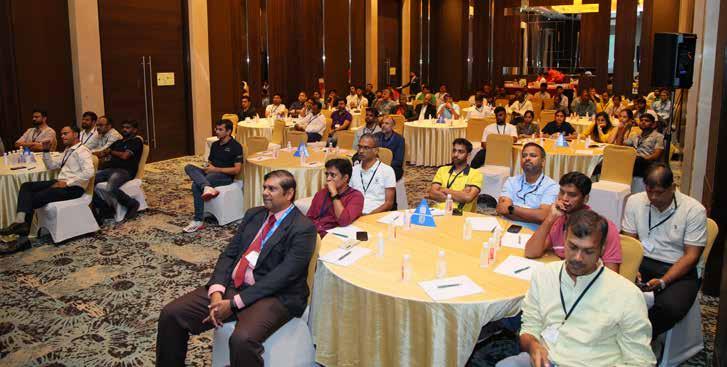
India-US trade negotiations have resumed finally weeks after Trump imposed steep 50% tariffs on India. On Tuesday, September 16,2025, India and US resumed trade negotiations, as U.S. Assistant Trade Representative Brendan Lynch arrived at Vanijya Bhawan in New Delhi. This session serves as preparatory groundwork for the sixth round of IndiaUS trade talks, originally scheduled for August but postponed after a U.S. decision to impose a 50% tariff on select Indian goods. India-US trade talks kicked off in New Delhi with U.S. Trade Representative Brendan Lynch meeting Commerce Ministry officials. Both nations target $500 billion in bilateral trade by 2030 amid dairy import
The All-India Transporters Welfare Association (AITWA) has welcomed the reduction in GST on trucks and tyres, a long-standing demand of the association, which is expected to stimulate truck purchases and reduce overall logistics costs.It said, “We sincerely appreciate the visionary leadership of Hon’ble Prime Minister Shri Narendra Modi, the proactive approach of the Finance Ministry , and the steadfast efforts of the Central Board of Indirect Taxes & Customs in implementing transformative reforms in the GST regime. The recent reduction in GST rates on trucks, tyres, and several ancillary items marks a significant and forward-looking step for India’s logistics and transportation sector. These reforms are bound to stimulate fresh investments across the industry, not only by large players but also empowering small truck owners and allied businesses.”AITWA supports the recent GST 2.0 reforms, particularly the reduction of GST on trucks and tyres, as it will lower logistics costs and boost demand, though they also

concerns. This was the first in person meeting after the US imposed 50% tariff last month. As New Delhi hosts the preparatory meetings, both sides will work to reconcile U.S. demands for dairy market access with India’s commitment
to protecting its small-scale farmers. The resolution of this core issue will be pivotal for successful conclusion of the sixth round and meeting the 2030 trade goal. According to reports, a senior US official said Washington was not aiming to compete in India’s sensitive mass dairy market, but its focus was on selling premium cheese to New Delhi. “It doesn’t make sense to export milk or yogurt to India. We are talking about high-end products like certain cheese varieties,” the US official said. The US is hopeful that negotiating with India on this segment would be more receptive to New Delhi as it doesn’t impact the small dairy farmers.
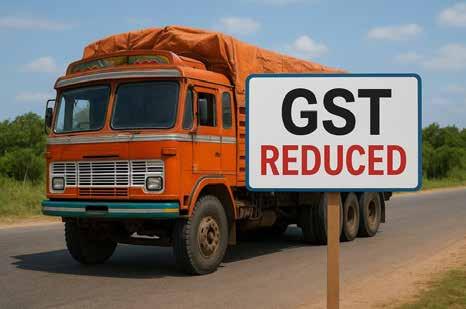
highlighted transitional challenges with the Reverse Charge Mechanism (RCM) and urged for a streamlined one-time transition window. AITWA expressed gratitude to the government for the rate rationalization, which it believes will empower small truck owners, improve logistics efficiency, and contribute to India’s economic growth towards a selfreliant nation. The association believes
these reforms will boost demand, enhance efficiency, and contribute to India’s goal of becoming a $5 trillion economy. The reforms are seen as beneficial for small truck owners and allied businesses, empowering them and fostering growth across the logistics ecosystem.
Adani Ports and Special Economic Zone (APSEZ) had recently completed the groundbreaking ceremony of the Adani Logistics Park in Kalamassery, Kochi. The ceremony was inaugurated by the Chief Minister of Kerala, Pinarayi Vijayan. The Adani Logistics Park is being developed under the Invest in Kerala initiative, marking a pivotal step in transforming Kerala into a logistics and industrial powerhouse. Speaking on the occasion, Chief Minister, said, “The foundation stone of the Adani Logistics Park, which will be started in Kalamassery as part of the state government’s ‘Invest in Kerala’ scheme, is being laid. Kerala has grown to be an investor-friendly state, not just an industry-friendly one. That is why the AdanGroup has decided to start this logistics park in Kerala.” The facility will feature EV charging stations, smart logistics solutions, and digital integration, emphasising sustainability
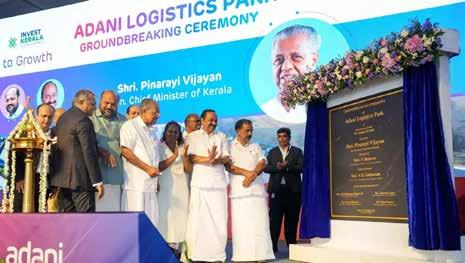
and innovation. The investment towards this will be over ₹600 crore and is expected to generate over 1,500 jobs, fostering local employment, skill development, and economic growth, while creating opportunities for SMEs to thrive within the supply chain ecosystem. Strategically located in Kochi- a city rapidly emerging as a hub
for industrial and logistics development, the park spans over 70 acres and is designed to reduce transportation costs, enable just-in-time operations, and enhance export capabilities across key sectors, including e-commerce, FMCG/ FMCD, pharmaceuticals, automotive, and retail.
India’s logistics & industrial leasing has surged 22% in the first half of the year 2025 according to Cushman and Wakefield’s H1 2025 Logistics & Industrials Marketbeat Report. The report mentions that India’s logistics and industrial real estate sector maintained strong momentum with leasing activity reaching 30.7 million sq. ft. (MSF) in the first half of 2025. This represents a 21.6 per cent year-on-year rise and is 12.1 per cent higher than H2 2024, underlining the sector’s resilience and robust demand. Warehousing continued to drive activity, contributing 21.9 MSF (71.3 per cent) of total leasing, while industrial space accounted for 8.8 MSF (28.7 per cent). Sector-wise, Engineering & Manufacturing (E&M) led overall absorption with 9.7 MSF (32per cent), marking a 37 per cent YoY
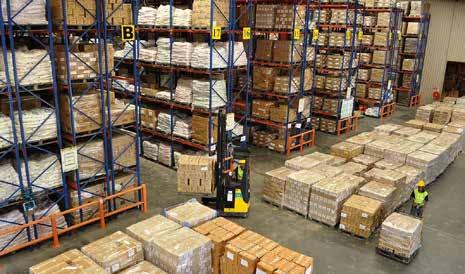
growth. While Mumbai’s warehousing market saw significant growth in H1 2025, driven by 3PL operators and sectors like FMCG and manufacturing, Bhiwandi was a key driver, accounting for over 80% of leasing activity. The report also highlighted that India has consistently surpassed 50 MSF of annual
leasing for three years in a row and with strong momentum in place, gross leasing is expected to cross 60 MSF by year-end, setting a new benchmark for the country’s logistics and industrial real estate market.
US tariffs imposed on Indian goods have significantly impacted cargo demand, particularly air cargo, with volumes to the US decreasing after the tariffs came into effect Air cargo exports from India to the US plunged after tariffs doubled to 50% on August 27, according to STAT Times , while WorldACD data reveals a shift in trade patterns as India-US spot rates fall below $4/kg and Europe emerges as an alternative destination for Indian exports. Volumes dropped by 12% in the week after the tariffs took effect and by another 14% in the first week of September. WorldACD figures show that volumes that in week 36, demand from India to Europe increased by 8% compared with last year. Exporters are considering or have already shifted towards sea freight to mitigate the higher costs associated with tariffs, as air freight becomes less economical for many Indian products. Some Indian exporters are focussing to
Flipkart is expanding its presence in Assam and neighbouring states with new warehouses, fulfilment centres, and seller partnerships in order to meet the festive season demand. Flipkart is stepping up its presence with a major push across supply chain, seller networks, and workforce initiatives in Assam and neighbouring states. The company has identified the region as one of its fastest-growing markets, reporting 35–40% year-on-year growth driven by rising digital adoption and increasing
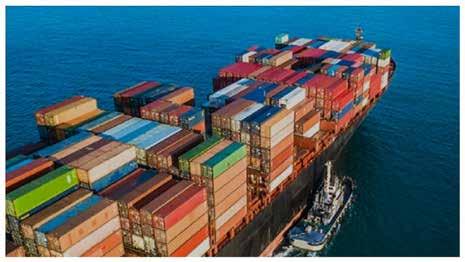
non-USA markets, impacting air cargo routes and potentially reducing demand on USA-bound shipments. Conversely, air cargo volumes from India to Europe have been rising steadily, increasing by 8% compared to last year in week 36 of 2025. Additionally, volumes from Sri Lanka to the US have increased significantly, standing 13% higher in
week 36 than in the equivalent week last year, potentially benefiting from diversion of trade away from India. While demand from India to the US has come under pressure in recent weeks, demand to Europe has been on the up.

consumer demand. Guwahati is central to this expansion, with Flipkart establishing over 6 lakh sq. ft. of warehousing covering large, non-large, and grocery categories, aimed at faster deliveries and wider product availability during peak months. In Tripura, a new grocery fulfilment centre in Agartala is set to handle up to 5,000 orders daily. Quick commerce is also a key focus. Flipkart Minutes, the company’s express grocery delivery service, is scaling operations in Guwahati, which
currently has nine Micro Fulfilment Centres, with more on the way. Across the Northeast, Flipkart operates 391 small-format hubs, including 31 in Guwahati, strengthening last-mile reach in urban and semi-urban areas. The seller ecosystem in the region is also expanding. Assam alone hosts more than 1 lakh sellers on Flipkart, with strong demand in categories like ethnic wear, footwear, grooming, children’s apparel, and home furnishings.
The Central Board of Indirect Taxes and Customs (CBIC) has issued the Customs (Finalisation of Provisional Assessment) Regulations, 2025, aimed at enhancing speed, certainty, and transparency in customs administration. The latest amendments in customs rules on provisional assessments of imports and exports will aid revenue protection, trade facilitation and bring closure to long-pending cases, say industry experts. The CBIC has implemented several new regulations to speed up import-export processes, including a waiver of transhipment permit fees, a simplified procedure for the temporary
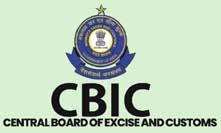
movement of Unit Load Devices (ULDs), and a new framework for handling post-export amendments electronically. Additionally, the National Time Release Study 2025 aims to identify and address bottlenecks, while the ICETAB system is being extended for paperless export examinations. By introducing clear
timelines, CBIC has addressed a pain point that has long burdened both trade and authorities. Businesses will experience faster release of blocked working capital, lower compliance costs, and improved predictability in supply chains. Experts are of the view, timely finalisation, while safeguarding the assessee’s right to present submissions, will be critical. If executed in the intended spirit, these regulations can balance revenue protection with trade facilitation, bringing closure to longpending cases and building greater trust between industry and administration.
Amazon India has announced a significant expansion of its operations network with the launch of 12 new fulfilment centers (FCs) and six new sort centers (SCs), ahead of the upcoming festive season. The move adds 8.6 million cubic feet of incremental storage capacity, equivalent to 100 Olympic-sized swimming pools, further strengthening its e-commerce logistics infrastructures. The new fulfilment centers have been launched across key cities, including Delhi NCR, Bengaluru, Kolkata, Nagpur, Thane, Visakhapatnam, Hubballi, Hooghly, Hyderabad, Tiruvallur, and Krishnagiri. With this, Amazon has introduced its first FCs in five cities: Hooghly, Tiruvallur, Krishnagiri, Visakhapatnam, and Hubballi. The six sort centers have been set up in Hubli, Trivandrum, Rajpura, Gorakhpur, Moradabad, and Prayagraj, covering a combined area of 500,000 sq. ft. This network expansion builds on Amazon’s earlier addition in June 2025 of five fulfilment centers
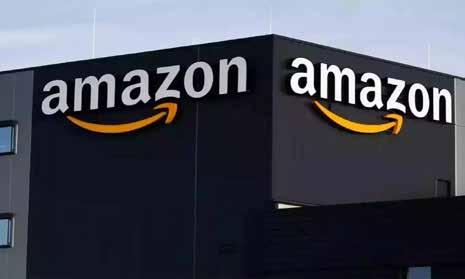
and over 30 last-mile delivery stations in cities such as Panchkula, Nagpur, Hubli, Mohali, Howrah, and Indore. The expansion is expected to create thousands of direct and indirect job opportunities, including positions for fulfilment and sortation associates, team leads, and process assistants. Amazon had recently created more than 150,000
seasonal roles across its operations network in over 400 Indian cities. This includes onboarding thousands of women associates and more than 2,000 persons with disabilities (PWD), reinforcing its commitment to diversity and inclusion.
Shipping is responsible for much of the world’s trade, yet it also makes climate change and ocean pollution more pronounced. The good news is that AI (artificial intelligence) can make ships sail better, cleaner, and safer.
Smarter Routes, Lower Emissions
AI can figure out better routes by looking at the weather, waves, and currents in real time. This is known as “weather routing.” A ship that stays away from storms and rough seas burns less fuel and gets to its destination on schedule. It’s like utilizing a smart map that finds the best water routes. Studies and advice from the industry reveal that routing that takes the weather into account uses less energy and burns less fuel.
Just‑In‑Time Arrivals
Just-In-Time (JIT) arrival is another huge win. Instead of rushing to a port and waiting with the engines running, AI helps a ship slow down during the trip so it gets to the harbor just when a berth is free. One study indicated that JIT can save fuel use and CO₂ by roughly 14% every trip. That’s a lot of money saved by a simple idea: don’t rush merely to wait.
Clean Hulls, Lean Fuel
AI also keeps an eye on the ship’s health. It tells you when to clean the hull or change the speed and power by keeping track of engine statistics and hull condition. Engines that are adjusted use less fuel, and a clean hull glides better. These tiny gains build up to large reduction in emissions over several journeys.
AI doesn’t just cut down on pollution; it also protects the ocean. Authorities can act fast to stop damage from spreading since satellite imagery and machine learning can quickly find suspected oil slicks. For example, Europe’s CleanSeaNet uses satellite data to find oil on the surface of the sea and figure out who might be polluting it. Scientists are additionally instructing AI how to scan radar photos and report spills in almost real time. AI on board checks sensors for leaks or strange discharges. Smart cameras can see when people are dumping trash at ports. You can stop problems early when you can see them early.
AI makes it possible for ships to “eco-drive.” It tells you the ideal speed, trim (how the ship sits in the water), and power settings for each part of the trip. It also allows fleets compare ships, communicate best practices, and plan maintenance to keep performance high. Ports may cut down on traffic and waiting time by using better data. This means fewer engines
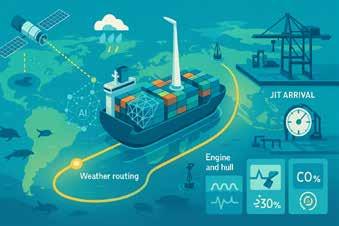
running and less pollution overall. These initiatives, together with new technologies like wind-assist and cleaner fuels, are making the sector more environmentally friendly.
The International Maritime Organization (IMO) has established a goal for shipping to reach net-zero greenhouse gas emissions by about 2050, with milestones along the way to check on progress. AI isn’t a magic bullet, but it is a powerful set of tools that can help us get there: smarter routing now, cleaner operations every day, and tighter monitoring to keep the oceans safe. If you combine AI with better ship designs and fuels that don’t produce carbon or very little carbon, you can reach those goals.
In short, AI helps ships consume less fuel, stay clean, and get to their destinations on schedule. It takes data and translates it into useful activities, such as smoother routes, cleaner hulls, and quicker spill detection. If shipping keeps using AI intelligently, the ocean will be cleaner, the air will be fresher, and the sector will be closer to a sustainable future.
The Author

Vishrut Srivastava Managing Director Yodaplus Technologies Pvt Ltd
For further insights on how AI can drive more environmentally friendly shipping practices — or to have a brief discussion on the topic — feel free to connect with me at vishrut@yodaplus.com
Shipbuilding sector to receive ₹70,000 crore investment across various schemes
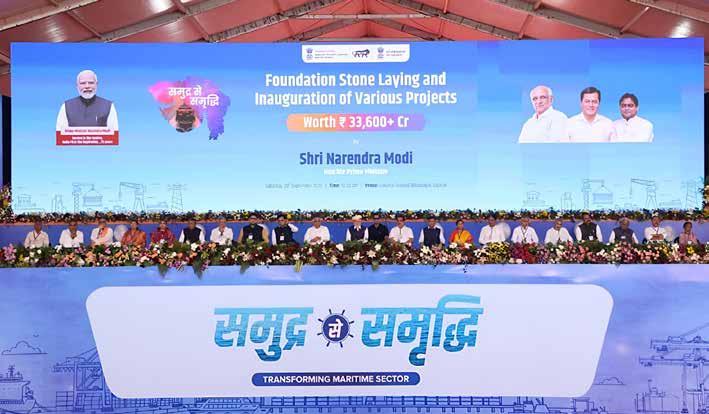
In a major boost to the maritime sector, Prime Minister recently inaugurated and laid the foundation stone for multiple development projects related to the maritime sector worth over Rs 34,200 crore in Gujarat.
“India was historically a leading maritime power and one of the world’s largest shipbuilding hubs. Ships built in India’s coastal states once powered domestic and global trade. Even 50 years ago, India used domestically built ships, with over 40 per cent of import-export conducted through them. However, the sector later fell victim to misguided policies of the previous government and instead of strengthening domestic shipbuilding, they preferred paying freight to foreign vessels,” said the Prime Minister Narendra Modi at an event in Bhavnagar Gujarat on Saturday September 21, 2025.
The PM Modi, while inauguration of the ‘Samudra se Samriddhi’ event, laid the foundation stone of development works worth over Rs 34,200 crore in Bhavnagar. Addressing
the event he also urged lending shipbuilding sector a push, as India loses $75B to foreign lines every year. PM Modi said that all major ports in the country will now be freed from multiple documents and fragmented processes.
Referring to the collapse of India’s shipbuilding ecosystem, Modi said, “India was historically a leading maritime power and one of the world’s largest shipbuilding hubs. Ships built in India’s coastal states once powered domestic and global trade.” Even 50 years ago, India used domestically built ships, with over 40 per cent of import-export conducted through them. However, the sector later fell victim to misguided policies of the previous government and instead of strengthening domestic shipbuilding, they preferred paying freight to foreign vessels.
The PM further stated that India pays nearly USD 75 billion or nearly Rs 6 lakh crore every year to foreign shipping companies for shipping services. “This amount is nearly
Shipbuilding and heavy fabrication company Swan Defence and Heavy Industries (SDHI) has signed a memorandum of understanding (MoU) with the Gujarat Maritime Board (GMB) for a strategic investment of Rs 4,250 crore.
Rear Admiral Vipin Kumar Saxena (retd.), CEO, Swan Defence and Heavy Industries, said, “By investing in infrastructure, capacity, and skill development we will add world-class capabilities that accelerate India’s shipbuilding ecosystem. SDHI is laying the foundation for a new era of growth and cementing our nation’s place on the global maritime map for decades to come.”
This strategic collaboration between SDHI and GMB aligns with the Maritime Amrit Kaal Vision 2047, ushering in a new era of growth, innovation, and global leadership for the Indian shipbuilding ecosystem. The partnership is set to modernise shipyard infrastructure, strengthen domestic supply chains and build a sustainable talent pipeline for India’s maritime industry.
The Rs 4250 crore investment will be deployed across three key projects at the shipyard in Pipavav Port, Gujarat, that is home to India’s largest dry dock, with capacity to build vessels up to 400,000 DWT.
The partnership will infuse Rs 3,500 crore for capacity expansion at the shipyard, including slipway, jetties, additional cranes, block fabrication, and dredging.
equivalent to India’s current defence budget. As a result, the share of Indian ships in trade dropped from 40 per cent to just 5 percent. Today, 95 per cent of India’s trade relies on foreign ships, a dependency that has caused significant loss to the nation,” Modi said.
One Nation, One Document’ and ‘One Nation, One Port Prime Minister Narendra Modi has called for strengthening of domestic shipbuilding The minister noted that India’s shipping sector has faced severe damage due to the flawed policies of the previous government. “If India is to become a developed nation by 2047, it must become self-reliant, there is no alternative to self-reliance and that all 140 crore citizens must commit to the same resolve—whether it is chips or
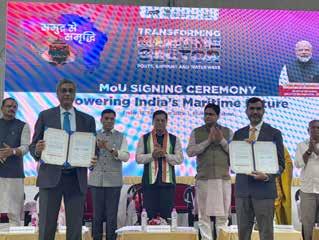
This will enhance the shipyard’s capacity to meet global as well as Indian shipbuilding demand.
A Rs 200 crore world-class Centre of Excellence (CoE) for Maritime will come up at the shipyard to deliver a certified, industry-ready workforce of over 1,000 youth annually. The CoE will be equipped with state-of-the-art smart classrooms, specialised labs, advanced simulators, and design software systems to enable innovation in ship design, shipbuilding, and retrofits.
SDHI will also develop a 200-acre Maritime Cluster within the shipyard for an investment of Rs 550 crore. The cluster will serve as a maritime hub for ancillary industries, suppliers, and support services to foster innovation, improve efficiency, boost local economy, and strengthen global trade.
ships, they must be made in India,” the Prime Minister added. He further stated that all major ports in the country will now be freed from multiple documents and fragmented processes. The implementation of ‘One Nation, One Document’ and ‘One Nation, One Port’ Process will simplify trade and commerce.
PM Modi emphasized that India possesses the capability and lacks no skill. He assured the nation that the political will be required to build large ships is firmly in place. Highlighting that a historic decision was taken yesterday to strengthen India’s maritime sector, Shri Modi announced a major policy reform under which large ships have now been accorded infrastructure status.
Shipbuilding and heavy fabrication company Swan Defence and Heavy Industries (SDHI) has entered into a strategic memorandum of understanding (MoU) with Sagarmala Finance Corporation (SMFCL), India’s maritime-focused NBFC. Under the partnership, SDHI & SMFCL will jointly explore projects including newbuilds, ship repairs and ancillary maritime infrastructure for support under Maritime focused Equity Fund (MfEF).
“We are proud to partner with SMFCL to establish a strong framework to create a sustainable, globally competitive shipbuilding ecosystem. This partnership will generate high-value jobs, boost exports, strengthen supply chains, and position India as a leading force in the global maritime economy,” said, Rear Admiral Vipin Kumar Saxena (retd), CEO, Swan Defence and Heavy Industries
Under the MoU, the partners will develop a financing plan covering capital structure, equity, debt, and credit enhancements, while identifying co-financiers such as multilateral institutions, government agencies, and private investors.
The MoU covers four strategic areas across technical and commercial evaluation, financing, project execution, and ecosystem development to advance shipbuilding in line with Maritime India Vision 2030, PM Gati Shakti, and India’s goal of becoming a global shipbuilding leader.
SDHI and SMFCL will conduct feasibility studies
Emphasising that to make India a major maritime power, the Government is working on three major schemes, the PM remarked that these initiatives will ease financial support for the shipbuilding sector, help shipyards adopt modern technology, and improve design and quality standards. He informed that over ₹70,000 crore will be invested in these schemes in the coming years.
Shipbuilding ‘Mother of All Industries’ PM Modi stated that India is now taking comprehensive steps to promote shipbuilding nationwide. He emphasized that shipbuilding is not an ordinary industry; it is globally referred to as the “Mother of All Industries” because it drives the growth of multiple allied sectors.
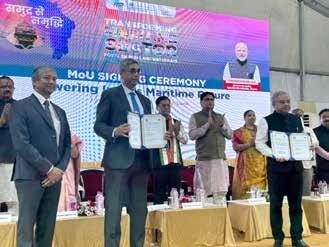
covering project design, yard capacity, vessel types, and technology integration. The partnership will drive adoption of advanced, sustainable shipbuilding technologies – such as green fuels, energy-efficient designs, and digital shipyards – while promoting localisation of supply chains, vendor development, and robust backward linkages to strengthen India’s maritime manufacturing ecosystem.
The partnership will drive sustainability and ESG reporting on emissions, safety, and labour standards, aligning India’s shipbuilding ecosystem with global benchmarks. SDHI and SMFCL will explore opportunities to boost vessel exports and engage in international shipbuilding value chains, while also developing a collaborative framework for industryacademia partnerships, skill development, and capacity building for the maritime workforce.
The Prime Minister highlighted that industries such as steel, machinery, electronics, textiles, paints, and IT systems are all supported by the shipping sector. He noted that this creates significant benefits for small and medium enterprises (MSMEs).
Citing research, the Prime Minister stated that every rupee invested in shipbuilding generates nearly double the economic return. He added that every job created in a shipyard leads to six to seven new jobs in the supply chain, meaning 100 shipbuilding jobs can result in over 600 jobs in related sectors, underscoring the massive multiplier effect of the shipbuilding industry. MMT
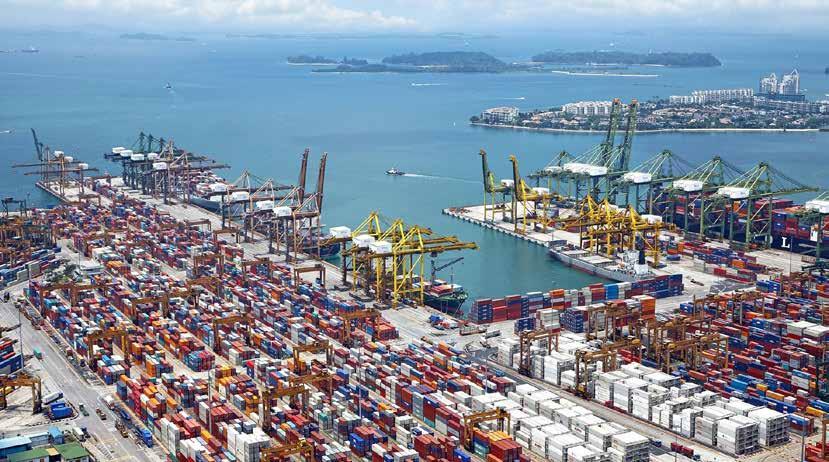
- Delphine Estibeiro
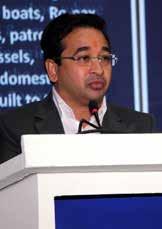
In a move industry stakeholders called decisive, Mr Nitesh Rane, Hon’ble Minister of Fisheries & Ports Development, Government of Maharashtra, unveiled a landmark initiative: the Maharashtra Shipbuilding, Ship Repair and Ship Recycling Policy 2025 on 10 September at INMEX SMM India in Mumbai.
Framing the policy as more than a document, Mr Rane described it as a “blueprint for making Maharashtra a shipbuilding and repair powerhouse,” signalling the state’s intent to translate India’s national ambitions into deliverable projects along its western coast.
Mr Rane told delegates the policy aims to position Maharashtra to supply roughly one-third of India’s shipbuilding and repair targets under the Maritime India Vision 2030 and the longer-term Maritime Amritkaal Vision 2047. “We are opening our coastline for serious industrial development, investment and technology partnerships,” he said, adding that the state will provide active facilitation to fast-track projects and approvals.
The policy designates six shipyard clusters — Dighi, Jaigarh, Dabhol, Vijaydurg, Nandgaon and Bhanpur — alongside 11 standalone shipyard locations. Mr Rane highlighted the clustered approach as a way to build scale, create supplier ecosystems and reduce lead times for shipyard mobilisation. “Clusters enable shared infrastructure, quicker procurement, and make projects bankable,” he informed.
To attract capital, the state is offering a mix of fiscal and project incentives: a 15% capital subsidy during execution, fiscal support of up to ₹5 crore or 60% of eligible project costs for infrastructure, R&D and workforce upskilling, and annual support for workforce recycling of up to ₹1 crore or 50% of training costs. The minister projected the policy could attract more than ₹18,000 crore in investment and support creation of some 1.4 lakh direct and indirect jobs by 2047.
Acknowledging environmental clearances and land allotment as the sector’s two perennial bottlenecks, Mr Rane committed to close coordination with central agencies to expedite approvals. “We will ensure time-bound environmental clearances without compromising ecological standards,” he said, promising clear land management rules and a waterfront allotment policy to speed site handovers.
He also emphasised transparency in land allocation, saying the state will publish clear procedures and timelines to reduce investor risk. “Investors must have certainty — clear rules,
predictable timelines and responsive governance,” he mentioned.
Mr Rane underlined the policy’s wider demandside thinking, announcing a DPR for passenger water transport in the Mumbai Metropolitan Region aimed at easing road congestion and creating a local market for vessels and maintenance services. He tied the state’s ambitions to national incentives such as support for green fuel vessels and the extended Shipbuilding Financial Assistance Policy, inviting investors to consider environmentally progressive shipbuilding projects in Maharashtra.
At the INMEX SMM India, Mr Rane made a direct appeal to domestic and international shipbuilders, financiers and technology partners: explore Maharashtra’s coastline for ancillary units, joint ventures and skill centres. “Let this exhibition be the start of projects, not just conversations,” he urged, promising the state’s full cooperation in land, permissions and investor facilitation.
He also pledged ongoing engagement with industry associations and maritime training institutions to ensure the policy’s incentives translate into a skilled workforce. “We will support workforce recycling and certification so that shipyards have access to trained hands from day one,” Mr Rane said.
With strategic coastline, policy incentives and political backing, Maharashtra has created a replicable model to translate national shipbuilding ambitions into state-level action. The policy’s impact will be measurable by the speed of land allotments, clarity of financing routes and the state’s ability to convert approvals into steel on the slipway. If executed effectively, Maharashtra can anchor a significant portion of India’s shipbuilding and repair capacity and catalyse jobs, technology adoption and greener fleet renewal.
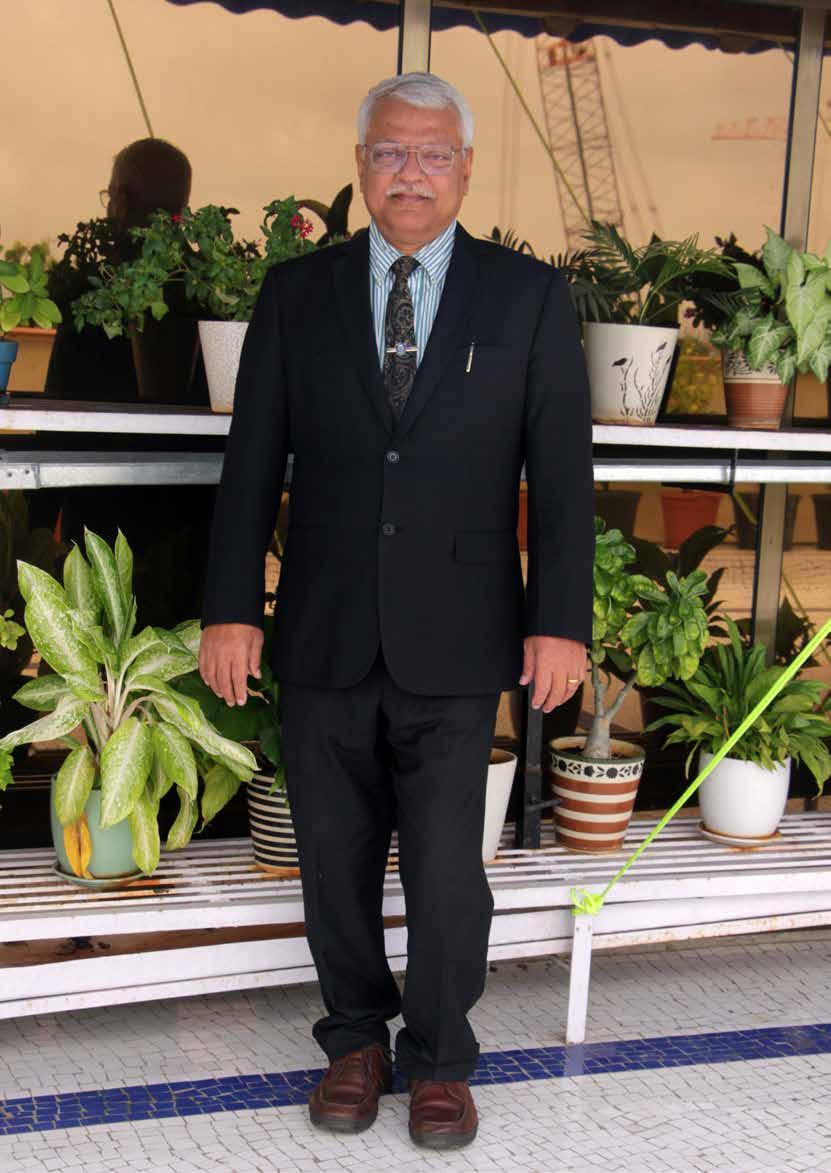
General
Secretary
The Maritime Union of India (MUI)
With over 36 years of service in the shipping industry — including 25 years as a sailing Master exclusively on tankers — Capt Savio Ramos brings a wealth of firsthand experience to his role as General Secretary of The Maritime Union of India (MUI). His association with the Union spans more than a quarter of a century, during which he has served as an Executive Committee member for six years and as Vice President for the past three.
For Capt Ramos, leadership is not merely a position but a calling. His long-standing commitment to seafarers’ welfare is rooted in lived experience: the challenges of extended contracts, restricted shore leave, evolving safety standards, and the constant need to adapt to new technologies. These insights drive his advocacy for fair representation, policy reform, and tangible support for the maritime community.
Beyond his professional responsibilities, Capt Ramos values balance and well-being, drawing energy from time spent with his family and tending to his garden — a pursuit he finds both meditative and creatively fulfilling. A firm believer in setting boundaries and prioritising personal connections, he has upheld traditions such as returning home for Christmas and taking annual family vacations, underscoring his belief that a strong personal foundation is essential for effective leadership.
During an in-depth discussion with Miss Delphine Estibeiro of Marex Media, Capt Ramos shares his vision for strengthening India’s voice in global shipping, championing fairness, fostering industry–academia collaboration, safeguarding rights, and steering Indian seafarers toward greater global influence — all while staying deeply connected to the realities of life at sea.
My vision is to build a stronger, more united Union that truly embodies the voice and spirit of every seafarer — championing their rights, ensuring welfare is accessible to all, and advocating for fair treatment across the
board. I am committed to addressing critical issues such as shore leave restrictions and the banning of off-signing from various ports, working closely with governments and relevant bodies to find lasting solutions. By fostering deeper collaboration with organisations and stakeholders, I aim to amplify our collective impact. Above all, I stand for fairness, transparency, and accountability, upholding our constitutional values to preserve the Union’s integrity and purpose.
I am committed to prioritising and advocating for the fair treatment of seafarers across India. This includes championing fair and timely wages that honour the dignity of their labour, and working proactively to address the challenges surrounding off-shore sign-offs, particularly in ports where disembarkation remains restricted. By engaging constructively with authorities and stakeholders, I strive to foster a more just and supportive environment for every seafarer navigating life at sea.
At MUI, we are deeply committed to securing stronger representation for Indian seafarers in international maritime forums. Our seafarers are among the finest in the world, yet their presence in international policy forums is not proportionate to their contribution. We are proposing to change this. Indian seafarers must not only participate but take the lead in shaping the future of global shipping.
Yes, absolutely. Collaboration between maritime training institutes and industry stakeholders is essential to bridging skill gaps and enhancing employability in today’s rapidly evolving sector. Increasingly, institutes are partnering with shipping companies to co-develop curricula, integrate simulation-based learning, and
promote continuous upskilling — ensuring graduates are not only technically proficient but also digitally literate and adaptable to emerging industry demands.
MUI is expanding its collaboration with key stakeholders to safeguard the rights and welfare of Indian seafarers. From ensuring fair wages and safe working conditions to providing crisis support and strengthening global representation, our commitment remains unwavering. Every Indian seafarer deserves dignity, protection, and equal opportunity on the world stage.
MUI envisions Indian seafarers as pivotal forces in shaping the future of global maritime labour standards. Renowned for their skill and adaptability, they are uniquely positioned to influence policies on fair wages, welfare, digitalisation, and sustainable shipping. By ensuring active representation in international bodies such as the IMO, ILO, and ITF, and by advancing training and leadership initiatives, we are committed to positioning Indian seafarers not merely as contributors, but as global leaders in building a fair, safe, and future-ready maritime industry.
Looking ahead, I hope my legacy at MUI will be one where every Indian seafarer feels empowered, respected, and proud of their profession. I want MUI to be remembered not only as a union that protected their
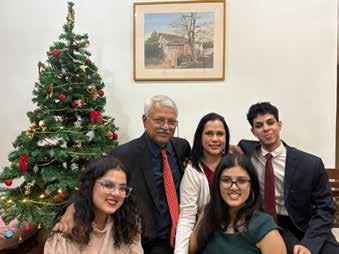
rights, but as one that enabled them to lead, innovate, and shine on the global maritime stage.
Having been a seafarer myself, I remain closely connected to the realities of life at sea by maintaining regular dialogue with crew members, and engaging directly with those on board. Firsthand understanding of our daily challenges — from long periods away from family and evolving safety and welfare needs to adapting to new technologies — guides every decision we make. This hands-on perspective shapes my leadership, ensuring that MUI’s policies, advocacy, and initiatives remain practical, responsive, and fully aligned with the needs of Indian seafarers.
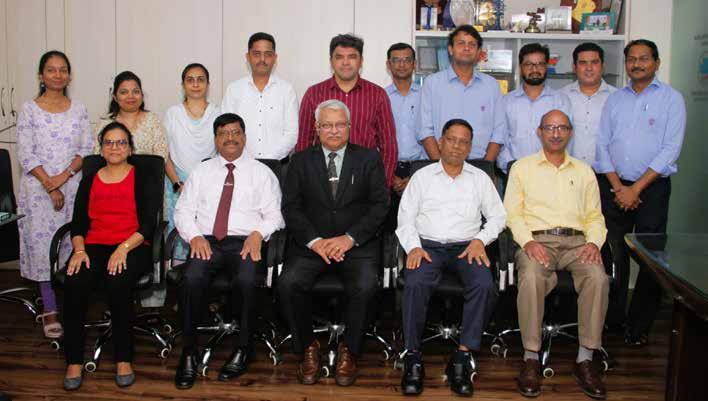
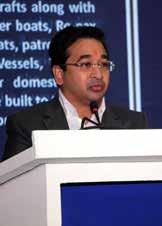
From September 10th to 12th, the Bombay Exhibition Centre in Mumbai hosted the 14th edition of INMEX SMM India, South Asia’s premier maritime trade fair and conference. The event brought together more than 9,000 visitors, 250 leading brands, and delegations from over 20 countries, cementing its role as a vital platform for advancing India’s maritime ambitions. With the central theme Building India’s Blue Economy: Shipbuilding & Repair as Growth Drivers, the exhibition underscored India’s determination to emerge as a global hub in shipbuilding, repair, and sustainable maritime solutions.
Organised by Informa Markets in India in partnership with Hamburg Messe und Congress GmbH, INMEX SMM India has grown into South Asia’s largest maritime showcase since the merger of INMEX India and Hamburg’s SMM India in 2014. This year’s edition was the biggest yet, featuring international pavilions from Germany, Greece, the Netherlands, and Korea, alongside a domestic shipyard pavilion, cutting-edge demonstrations, and strategic dialogues through the Maritime Leaders’ Forum, CTO Conclave, and Maritime Excellence Awards.
The inaugural session was marked by visionary speeches from policymakers and industry leaders who outlined the course for India’s maritime future. Mr Shantanu Thakur, Minister of State for Ports, Shipping & Waterways, in a video address, reiterated India’s aspiration to rank
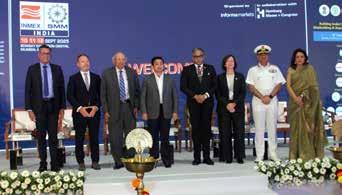
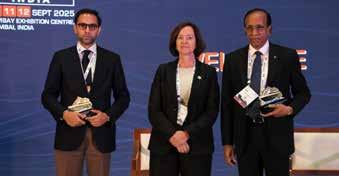
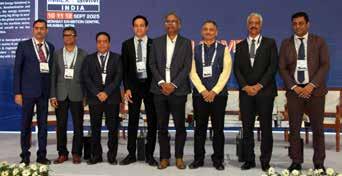
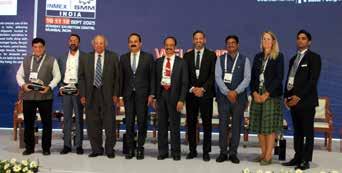
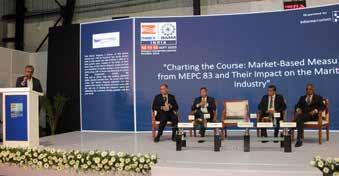
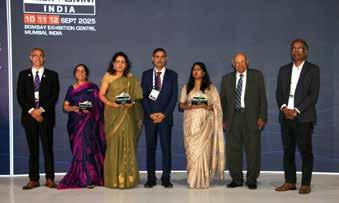
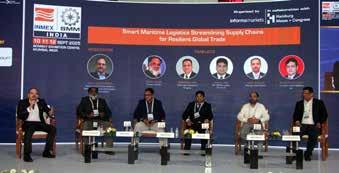
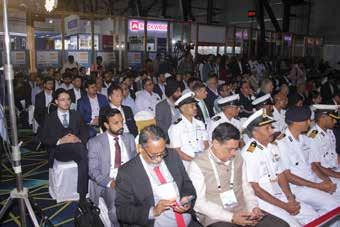
among the top 10 maritime nations by 2030 and top 5 by 2047, highlighting shipbuilding and repair as key growth drivers. “Our goal is clear — to position India as a new hub for shipbuilding and to be among the top ten maritime nations by 2030, and among the top five by 2047,” he declared.
Mr Nitesh Rane, Minister for Fisheries & Ports Development, Government of Maharashtra, announced the landmark Maharashtra Shipbuilding, Ship Repair, and Ship Recycling Policy 2025, the country’s first
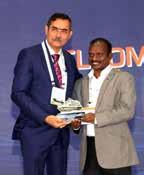
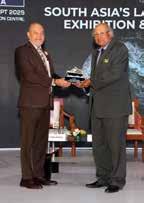
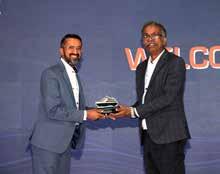
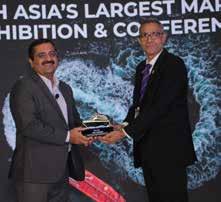
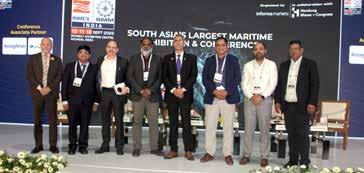

state-level initiative dedicated to this sector. The policy envisions six shipyard clusters and 11 standalone shipyards, alongside fiscal incentives, capital subsidies, and infrastructure development. With a projected ₹18,000 crore investment and 1.4 lakh new jobs by 2047, the policy places Maharashtra at the heart of India’s maritime transformation. Underscoring India’s longterm vision, Mr Rane remarked, “India must be among the top 10 shipbuilding nations by 2030 and among the top 5 by 2047.”
Adding a global perspective, Ms. Monica Nagelgaard, Consul General of Norway in Mumbai, emphasized IndoNorwegian collaboration in clean fuels, electrification, and sustainable shipbuilding. She remarked, “By combining Norway’s innovation ecosystem with India’s scale, talent, and ambition, we can create solutions that not only serve our two nations, but also set global benchmarks for sustainability.” Her remarks echoed the spirit of international cooperation that defined this year’s edition.
Inspector General Bhisham Sharma, Commander Coast Guard (Region West), highlighted the Coast Guard’s critical role in safeguarding India’s maritime domain, reaffirming its commitment to vigilance, innovation, and environmental stewardship. Meanwhile, Mr
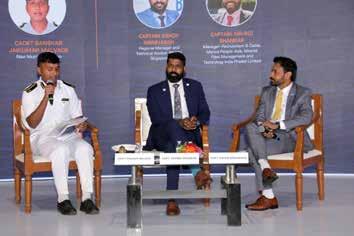

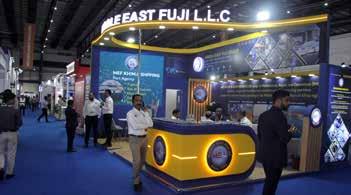
Ulas Boyaci, COO Exhibitions, Hamburg Messe und Congress GmbH, underlined INMEX’s role as a bridge between Europe and India, inviting Indian stakeholders to SMM Hamburg 2026 and celebrating the strong European participation this year.
With policy reforms, industry-wide collaboration, and a strong focus on innovation and sustainability, INMEX SMM India 2025 served not only as an exhibition but also as a catalyst for India’s maritime renaissance. The event showcased how India, backed by ambitious visions such as Maritime India Vision 2030 and Amrit Kaal Vision 2047, is positioning itself to be a global maritime powerhouse in the decades ahead.
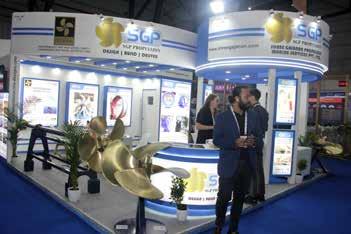
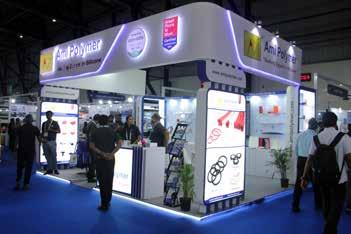
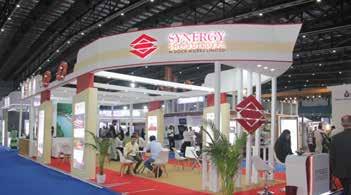
The updated framework GST 2.0 replaces the previous four-slab with a streamlined two-rate structure of a 5% rate for essential goods and an 18% standard rate for most goods and services
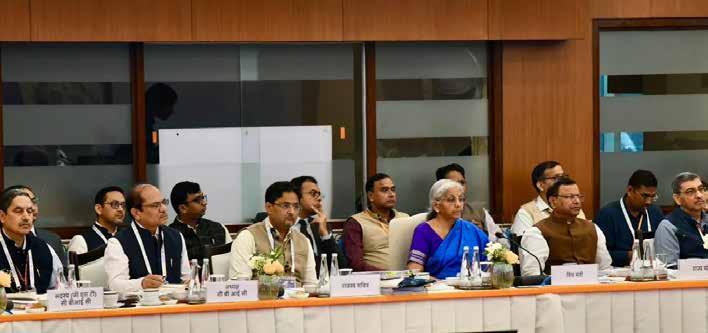
The 56th GST Council, convened on September 3, 2025, announced significant GST regime revisions effective September 22, 2025. These changes streamline the tax structure to two rates: 5% for essential goods and 18% for most others. The council addressed clarifications on medicines, drones, bricks, insurance, hotel accommodations, and transportation services, impacting businesses and consumers. The updated framework replaces the previous four-slab system (5%, 12%, 18%, and 28%) with a streamlined two-rate structure: a 5% rate for essential goods and an 18% standard rate for most goods and services.
The government states that GST 2.0 will help by simplifying the tax structure with fewer rates (primarily 5% and 18%, with a 40% rate for luxury goods), reducing costs for consumers and businesses, especially in sectors like electronics, automobiles, and textiles, which will boost overall demand and economic growth. The reforms are also expected to increase compliance, ease inflationary pressures, and create a more stable environment for businesses.
According to government officials the “New GST 2.0” reforms of September 2025 are primarily affecting sectors with reduced GST rates on essentials and consumer goods, including food and beverages, pharmaceuticals, agriculture, textiles, automobiles, and consumer electronics, while impacting tourism and hotels with a new rate structure.
The two-slab structure (5% & 18%) replaces the older system, increasing affordability of many daily items and promoting growth in employment-intensive and green energy sectors. Accordingly Full GST exemption on individual life and health insurance policies.
Food and FMCG: GST on essentials like milk, bread, and other staples is reduced or nil, increasing household savings and demand for these goods. Essential goods such as Ultra-High Temperature (UHT) milk, paneer, and Indian breads now carry nil GST.
Pharmaceuticals and Healthcare: Life-saving drugs and critical medicines see significant GST reductions, improving access and affordability. GST on 33 lifesaving drugs has been reduced from 12% to nil. GST on three critical drugs used for cancer and rare diseases has been reduced from 5% to nil, strengthening healthcare access.
Agriculture and Rural Sectors: GST on tractors, farm machinery, fertilizers, and irrigation equipment is cut, lowering input costs for farmers. Machinery like tractors, harvesters, and composters: GST reduced from 12% to 5%.
Similarly, while Fertilizer inputs such as sulphuric acid, nitric acid, and ammonia, GST is reduced from 18% to 5%, on Labour-intensive goods like handicrafts, marble, and leather items GST is reduced from 12% to 5%.
Textiles and Apparel: Branded apparel and footwear receive tax relief, boosting sales and helping the organized sector compete with the unorganized sector.
Consumer Goods and Automobiles: TVs, air conditioners, dishwashers, and refrigerators see lower rates, making them more affordable for consumers. GST on small cars, TVs, air conditioners, cement, and auto parts has been reduced from 28% to 18%. These cuts are expected to stimulate manufacturing, promote green energy adoption, and boost domestic demand.
Renewable Energy: GST on renewable energy devices is reduced, promoting the adoption of green energy. GST on renewable energy devices has been reduced from 12% to 5%.
Hotels and Tourism: Hotels now have different rates based on room tariff, with GST on rooms up to Rs. 7,500 reduced to 5% (without Input Tax Credit).
Logistics: Simplified GST and improved dispute resolution processes are expected to reduce costs and improve predictability for logistics businesses. However, the increase in the GST rate for labour charges, from 12% to 18%, has also led to some resistance, with small entrepreneurs saying that they would be hit hard by the change.
Insurance: Insurance premiums will see reduced costs, making services more affordable for consumers.
Impact on MSMEs (Micro, Small, and Medium Enterprises)
Simplification and Compliance: Process reforms for refunds and registration aim to reduce litigation and simplify compliance for MSMEs, making them more competitive.
Trade Facilitation and Dispute Resolution: The Goods and Services Tax Appellate Tribunal (GSTAT) will be operational by December 2025. Process reforms for refunds and registration will improve dispute resolution, reduce litigation, and provide predictability for businesses, especially MSMEs.
Benefits as Anticipated
Boosted Demand: Lower prices on goods and services are intended to increase consumer purchasing power and stimulate demand.
Cost Reduction: Lowering taxes helps in reducing costs for both consumers and businesses.
Simplified Tax Structure: The shift to a two-slab structure (5% and 18%) simplifies the tax regime and provides greater clarity.
Increased Affordability: The primary aim is to make essential goods and services more affordable, particularly for the common man, middle-class families, and farmers.
While the industry in general have welcomed the New GST 2.0 reforms there are many questions that remains to be answered. While economists are of the view that the reforms may lead to a fiscal revenue shortfall creating a further fiscal pressure on both the central and state governments, forcing them to either cut expenditures or increase borrowing. Also, they mention that those States dependent on GST revenue transfers may curtail spending on welfare and infrastructure, potentially slowing growth.
Ambiguity persists on Rate Structure and Classification as simplification to fewer slabs helps, but classification disputes persist over which goods fall under given categories. Special rates and the new 40% slab for sin goods increase complexity in areas such as luxury and harmful goods taxation. Moreover, frequent adjustments risk instability and uncertainty for businesses, impacting investment and pricing decisions.
Most of the entrepreneurs across sectors have no clarity over the Input Tax Credit (ITC) and Cascading Tax Issues. An owner of an enterprise on the condition of anonymity said, “Exemptions and zero-rated supplies restrict eligibility for ITC, leading to cascading taxes on inputs. This undermines GST’s principle of seamless credit flow and adds hidden costs to production and prices.”
For example, sectors producing exempt goods face higher effective taxes, feeding into inflationary pressures upstream.
Although slabs are rationalized, businesses face transitional compliance burdens, including recalibrating pricing, billing systems, and ERP updates.
Textile industry hails revision of GST rates
The textile industry, which welcomed the revision of GST rates for the textile value chain in both the manmade fibre and cotton sectors, have however expressed disappointment over the 18% duty for garments priced above ₹2,500 each.
New GST 2.0 is expected to reduce the logistics cost and shall bring in new reforms with global competitiveness.
Lower GST rates on transport services, particularly for multimodal, container rail, and road haulage, will reduce operating costs and door-to-door cargo charges. Transporters can choose between a 5% rate (with restrictions on ITC) or an 18% rate (with full ITC), providing flexibility to optimize based on their capital expenditure and service offerings.
AITWA supports the recent GST 2.0 reforms, particularly the reduction of GST on trucks and tyres, as it will lower logistics costs and boost demand, though they also highlighted transitional challenges with the Reverse Charge Mechanism (RCM) and urged for a streamlined one-time transition window. AITWA expressed gratitude to the government for the rate rationalization, which it believes will empower small truck owners, improve logistics efficiency, and contribute to India’s economic growth towards a selfreliant nation.
However, GST 2.0 can create new challenges to e-commerce, delivery platforms and gig worker. Increase in the GST rate for labour charges, from 12% to 18%, has also led to some resistance, with small entrepreneurs saying that they would be hit hard by the change.
MSMEs may lack the capacity to swiftly adapt, facing higher compliance costs and learning curves. The GST Network (GSTN) and government leverage technologies like AI and data analytics to improve compliance and detect evasion, but frequent rule changes still complicate adherence. The GST Appellate Tribunal (GSTAT), essential for resolving disputes quickly, remains non-functional or delayed in several states. For instance, GST appellate benches are still not functional at 45 locations. This leads to a backlog of appeals in High Courts and prolonged litigation, increasing uncertainty and compliance risks. Administrative inefficiencies undermine taxpayer confidence and delay the resolution of disputes critical to smooth GST functioning.
Though the Next-Generation GST reforms represent a bold step towards building a simpler, fairer, and future-ready tax architecture, but then all-inclusive and forward-looking measures are to be adopted to strengthen the GST 2.0 reforms. MMT
- Pratik Bijlani
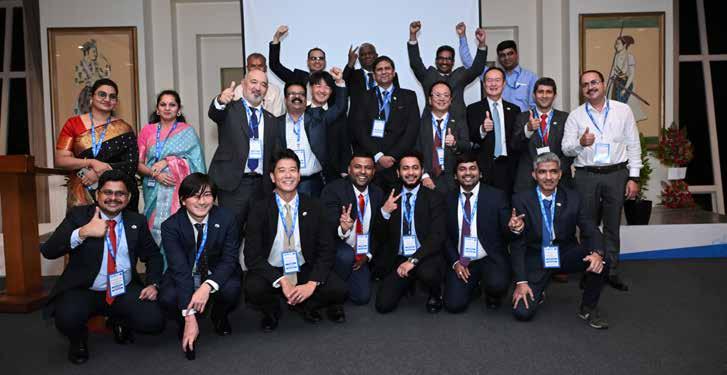
On 18th September, ClassNK marked an important milestone as it celebrated the 40th anniversary of its Mumbai office with a grand event at the Hotel Trident, Mumbai. The occasion brought together leading figures from the maritime fraternity, including shipowners, ship managers, regulators, and industry stakeholders, all gathered to commemorate four decades of service and contribution to India’s shipping industry. Since its establishment in 1985, the ClassNK Mumbai office has been a cornerstone of support for Indian shipowners and shipyards, providing world-class classification, certification, and technical advisory services. Over the years, it has grown into a trusted partner, contributing significantly to India’s rise as a global maritime power.
The evening’s celebrations highlighted ClassNK’s enduring commitment to safety, quality, and innovation, while also emphasizing its role in advancing sustainable shipping practices and environmental responsibility. The event began with a warm welcome address by Mr Sumithran Sampath, General Manager
at ClassNK, who also served as Master of Ceremonies. He underscored ClassNK’s position as a global leader with over 9,500 ships under its class, extended a heartfelt welcome to President & CEO Mr Hayato Suga and senior executives, and acknowledged the efforts of the teams behind a special video presentation that showcased ClassNK’s 40-year journey in India.
In his keynote speech, Mr Suga reflected on ClassNK’s longstanding ties with India, which date back to the 1950s when the organization established its first global technical committee in the country. He traced the expansion from the Mumbai office in 1985 to the establishment of five offices across India, highlighting milestones such as drawing approval functions and successful newbuilding projects. Expressing gratitude to employees, clients, and partners, he reinforced the organization’s vision of supporting India’s ambition to emerge as a top five shipbuilding nation by 2047, with an emphasis on collaboration and sustainability. “This anniversary is not just
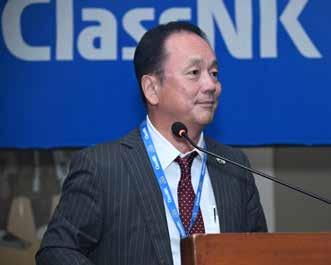
Hayato Suga, President & CEO of ClassNK, earned his bachelor’s degree in Ocean Engineering from Hiroshima University in 1986 and joined the society the same year. Over the course of his distinguished career, he gained expertise in plan approval and on-site surveys, later managing survey activities across Europe and Africa from the London Office. Upon returning to Japan, he played a pivotal role in the development of tanker standards and served as both member and chairperson of the Tanker Structure Co-operative Forum. He went on to hold senior leadership positions, including Director of the Plan Approval Division and Director of the Planning Division, before being appointed Executive Vice President in 2022 and Senior Executive Vice President in 2024.
Reflecting on the rapidly evolving maritime landscape, Mr. Suga observes: “The business environment is changing rapidly, with boundaries between industries becoming increasingly blurred due to environmental challenges and digital transformation. In response, our mission is to provide certification and related services in a timely manner to meet these diverse and fast-evolving needs—just like a top sushi chef serves the finest ingredients at the perfect moment. By doing so, we aim to connect industries through trust and contribute to the sound development and sustainable operation of the maritime sector.”
Mr. Suga engages in an insightful dialogue with Mr Pratik Bijlani of Marex Media, elucidating his reflections on four decades of experience, his vision for the future, strategies for bolstering India’s shipbuilding sector, the translation of strategic intent into tangible outcomes, stewardship of maritime investments, and the provision of pragmatic industry perspectives.
We are truly pleased to mark the 40th anniversary of our Mumbai office. This milestone reflects our enduring commitment to the maritime industry—not only in Japan,
but globally. As we celebrate this achievement, we remain dedicated to contributing meaningfully to the sector for decades to come. Whether over the next 8 years or the next 40, our focus will continue to be on advancing maritime excellence and collaboration.
Yes, particularly in the Indian context, we are keen to deepen cooperation with the maritime industry, local enterprises, and government stakeholders. Our core business currently centers on ship inspection, approval, and certification. Looking ahead, we aim to support the growth of India’s shipbuilding sector and offer timely support on emerging vessel types.
As a classification society, we operate as an independent third party and a non-profit organization. Our evolving role increasingly involves supporting industry development, helping to foster a more efficient and sustainable maritime ecosystem. We believe this contribution is vital to strengthening the industry’s long-term cycle of innovation and operational excellence.
While specific targets may not yet be guaranteed, they are actively pursued by policymakers and industry leaders alike. From our perspective, it is important to approach these ambitions with pragmatism. The International Maritime Organization (IMO) has already taken several strategic steps, and it is now essential to translate these into practical, actionable measures. We believe that through steady implementation, meaningful results will follow.
Before industry stakeholders make decisions regarding investment, collaboration, or placing orders, they require reliable estimations and tangible indicators. Practical actions must be accompanied by clear milestones and symbolic markers that signal progress and potential. Establishing these reference points is essential to fostering confidence and facilitating strategic decision-making within the maritime sector.
Here in Mumbai—and beyond—we have undertaken detailed investigations into emerging fuels and new maritime technologies. Our aim is not merely to provide surface-level information, but to deliver in-depth insights that are genuinely useful to shipowners and operators. We strive to ensure that our findings are both practical and thoughtfully presented, enabling stakeholders to make informed decisions with confidence.
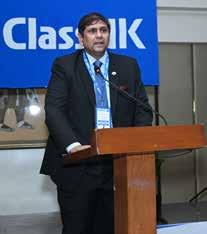
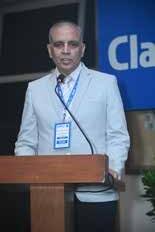
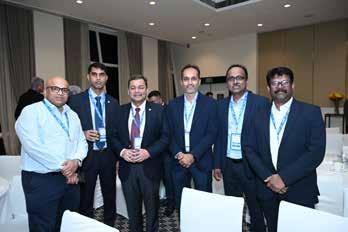
a reflection of the past but the beginning of a new voyage we hope to undertake hand-in-hand with all of you,” said Mr Suga, capturing the forward-looking spirit of the occasion.
Following this, Mr. Manish Jha, Chairman of ClassNK Indian Technical Committee, extended his heartfelt congratulations to the Mumbai office, drawing a personal parallel with his own 40-year journey in shipping. He commended the office’s role as a valued partner for shipowners, ship managers, shipyards, and training institutes, emphasizing how ClassNK’s audits have added value and contributed to the growth and recognition of institutions across the nation. Sharing his insights on collaborative R&D, he highlighted successful initiatives such as the SEEMS system, which gained international recognition after receiving ClassNK’s innovation endorsement. “Today, with confidence, I can say that ClassNK Mumbai office has become a trusted partner for ship owners, ship managers, shipyards, ship recycling yards and many other stakeholders” he said, underlining the institution’s widespread impact.
The celebration also featured a gesture of goodwill from Mr. Thimira S. Godakumbura, Managing Director of Colombo Dockyard PLC, who presented a small token of appreciation to Mr. Suga. The evening concluded with dinner and drinks, offering attendees an opportunity to celebrate the legacy of ClassNK Mumbai while looking ahead to its continued contribution to India’s maritime growth story.
MMT
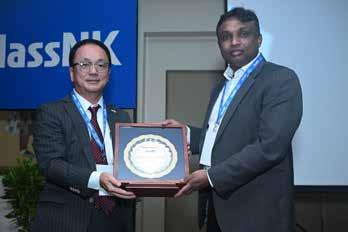
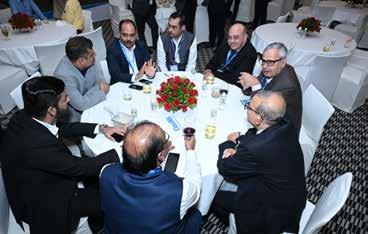

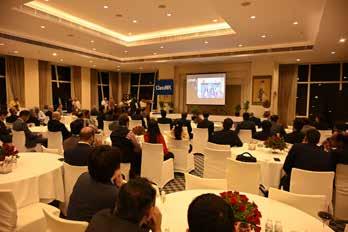
- Dr. Radhika Vakharia
The logistics industry in 2025 is dynamic, digital, and demanddriven. As new technologies emerge and global uncertainties persist, the ability to innovate and adapt has become essential. From AI-driven decision-making and sustainable practices to lastmile automation and supply chain resilience, logistics professionals must embrace change to remain competitive.
The logistics industry is undergoing a profound transformation. Driven by technological advancements, evolving customer expectations, and a global push toward sustainability, logistics is no longer just about moving goods from Point A to Point B. Instead, it’s about precision, efficiency, visibility, and resilience. As we move through 2025, several key trends are shaping the future of logistics and redefining how companies manage their supply chains.
Top 10 logistics trends to watch this year
1. AI and Machine Learning for Predictive Logistics
Artificial Intelligence (AI) and Machine Learning (ML) are becoming indispensable tools in logistics. Companies are using these technologies to predict demand, optimize routes, and manage inventory with greater precision. Predictive analytics, driven by AI, enables businesses to foresee disruptions and respond proactively.AI-powered forecasting tools can analyze weather patterns, traffic conditions, and port delays to suggest alternative routes in real-time, improving delivery reliability and customer satisfaction.
2. Sustainable and Green Logistics
Environmental sustainability is no longer optional—it’s a necessity. Consumers, regulators, and investors are demanding greener operations. This has pushed logistics providers to adopt eco-friendly practices such as:
• Electrification of delivery fleets
• Carbon-neutral shipping options
• Optimization of packaging to reduce waste
• Investments in alternative fuels like hydrogen or biofuels
Carbon footprint tracking tools are also becoming mainstream, helping companies measure and report on emissions transparently.
3. Automation and Robotics in Warehousing
Warehouse automation continues to grow rapidly in 2025. Robots, automated guided vehicles (AGVs), and drones are taking over repetitive tasks, improving speed and accuracy while reducing labor costs. Leading warehouses now deploy:
• Robotic arms for sorting and packing
• Automated storage and retrieval systems (AS/RS)
• AI-powered inventory management systems
This trend addresses the ongoing labor shortages in the logistics sector and enables faster fulfillment.
4. Last Mile Delivery Innovation
The “last mile” — the final leg of delivery to the customer — remains the most complex and costly part of logistics. To streamline last-mile operations, companies are leveraging:
• Electric and autonomous delivery vehicles
• Micro-fulfillment centers in urban areas
• Crowdsourced delivery (gig economy drivers)
• Delivery drones for rural or hard-to-reach areas
Real-time tracking, narrow delivery windows, and flexible scheduling have become standard expectations among consumers.
5. Blockchain for Supply Chain Transparency
Blockchain technology is gaining traction for ensuring transparency, security, and traceability in supply chains. By creating tamper-proof records of transactions, blockchain enables:
• Real-time tracking of goods
• Verification of product authenticity
• Enhanced collaboration between stakeholders

MS. MANISHA
THAKER, Vice President at Trialliance
Solutions,
Global
EXIM Faculty and Corporate Trainer expressed how blockchain is no longer just a buzzword , it is a powerful tool driving transparency, authenticity, and collaboration in supply chains. By enabling real-time tracking and trust among all stakeholders, blockchain is shaping the future of global trade. The result is a smarter, faster, and more reliable supply chain that benefits businesses and consumers.
Industries like pharmaceuticals, food, and luxury goods are leading adopters, where traceability and anti-counterfeiting measures are critical.
Many businesses are turning to third-party (3PL) and fourthparty logistics (4PL) providers to manage increasingly complex supply chains. This allows companies to focus on core competencies while outsourcing warehousing, transportation, and fulfillment.
In 2025, 4PL providers are going beyond basic logistics, offering integrated services that include technology platforms, data analytics, and end-to-end visibility — effectively becoming strategic partners rather than just service vendors.
The e-commerce boom shows no signs of slowing. With more consumers shopping online, logistics providers must scale operations to handle higher volumes, faster turnaround times, and higher return rates.
Key trends in e-commerce logistics include:
• Omnichannel fulfillment (online, in-store, click-and-collect)
• Dark stores and micro-warehouses near city centers
• Reverse logistics systems for handling returns efficiently Retailers are also integrating logistics functions within their digital platforms for real-time stock updates and delivery tracking.
Big data and advanced analytics are at the heart of logistics decision-making in 2025. Logistics companies are leveraging data from various sources — GPS, RFID, IoT sensors, and customer feedback — to optimize operations and improve performance.
Use cases include:
• Route optimization and fuel efficiency
• Demand forecasting
• Risk assessment and mitigation
• Real-time visibility into supply chain activities
Data-driven logistics not only reduces costs but also enhances agility and responsiveness.

MR. AMIT MAHESHWARI, Founder and CEO, Softlink Global expressed how ERP platforms are changing the face of logistics and why it is amongst the top trends today. “Our ERP platform, the Logi-Sys Intelligent Cloud ERP Platform, is designed to simplify the complex world of logistics. It brings freight, customs, finance, taxation, transport, and warehousing together on one system, cutting silos and saving time. With realtime visibility, built-in compliance, and AI-driven workflows, forwarders can work faster and with fewer errors. Seamless digital connections with shipping lines, airlines, ports, and customs further reduce manual effort. This helps logistics companies not only improve service but also boost profitability. Guided by our Think Forward philosophy, we are now building BoxyAI as the brain of Logi-Sys — bringing intelligence, insights, and automation to every step of logistics operations.”
As logistics becomes more digital and connected, cybersecurity has become a top priority. Cyberattacks targeting supply chain software, GPS systems, and customer data are on the rise.
In response, companies are investing in:End-to-end data encryption,Secure cloud-based logistics platforms, Multi-factor authentication and access control and Cyber incident response strategies.Ensuring digital trust is essential for maintaining operations and customer confidence.
The disruptions caused by global events (pandemics, geopolitical tensions, climate change) have highlighted the importance of building resilient and agile supply chains. In 2025, companies are shifting from cost-optimized models to risk-aware strategies.
Key strategies include:
• Nearshoring and reshoring to reduce dependence on distant suppliers
• Multi-sourcing instead of single-sourcing
• Strategic stockpiling of critical inventory
• Scenario planning and digital twin simulations
Agility now trumps efficiency, and companies that can adapt quickly gain a competitive edge.
Organizations that invest in smart logistics strategies today will be better positioned to thrive in the increasingly complex and fast-moving world of tomorrow. The convergence of technology, sustainability, and customer-centricity is not just shaping the future of logistics—it’s already here.
- MMT
The state-of-the-art facility with Full Mission Simulators, ECDIS, and AR/VR Labs to revolutionise hands-on maritime training for future seafarers
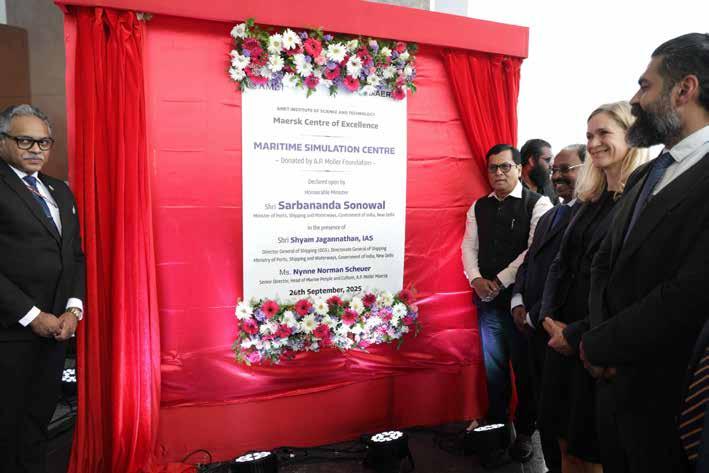
Chennai, 26 September 2025: Union Minister of Ports, Shipping & Waterways, Shri Sarbananda Sonowal, today inaugurated India’s first-of-its-kind Maritime Simulation Centre at AMET Knowledge Park, Maersk’s Centre of Excellence, Thenpattinam near Chennai. Also present at the inauguration ceremony was Shri Shyam
Jagannathan, IAS, Director General of Shipping, Mr Peter Winther-Schmidt, Head of Trade and Innovation, Consulate General of Denmark, Bangalore, senior delegates from A.P. Moller – Maersk, and hundreds of budding seafarers.
The cutting-edge facility has been established through a strategic partnership between the Academy of Maritime
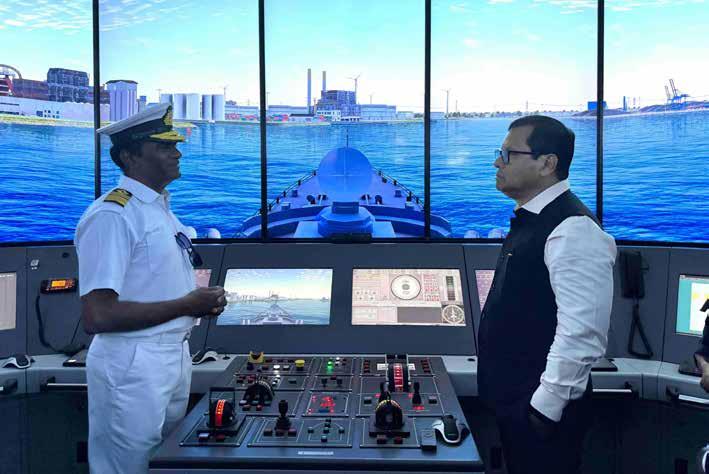
Education and Training (AMET), a Deemed-to-be University, and A.P. Moller-Maersk. The facility has been established with an investment of INR 13.5 Crore, including support from the A.P. Moller Foundation, which contributed approximately INR 6.5 Crore (USD 750,000) to the project, further strengthening the 25+ year collaboration between AMET and Maersk.
The Maritime Simulation Centre features state-of-the-art technology, including Full Mission Simulators for Deck and Engine operations, Electronic Chart Display and Information Systems (ECDIS), and advanced Augmented Reality/Virtual Reality (AR/VR) laboratories. These systems will provide cadets with immersive, hands-on training in critical maritime skills, including watchkeeping and steering, collision avoidance, navigation light identification, and engine troubleshooting.
Mr. Rajesh Ramachandren delivered the Welcome Address, setting the tone for the ceremony and acknowledging the collaboration between AMET and Maersk.
Speaking at the inauguration, Honourable Union Minister Shri Sonowal commended the collaborative efforts, stating: “AMET University and Maersk have demonstrated exceptional commitment to nurturing India’s maritime talent. This worldclass facility will empower our young professionals with the advanced skills needed to excel in the global shipping industry.
Such initiatives are crucial for strengthening India’s position as a maritime nation and developing the next generation of skilled seafarers.”
Dr J. Ramachandran, Founder & Chancellor of AMET University, emphasised the institution’s long-standing commitment to maritime excellence: “For over three decades, AMET has been at the forefront of maritime education in India. From our humble beginnings with just 14 cadets, we have grown into a globally recognised institution. This Maritime Simulation Centre represents our continued dedication to developing world-class maritime professionals. It stands as a testament to our vision of making AMET a global maritime knowledge hub that produces competent seafarers ready for the challenges of modern shipping.”
Ms Nynne Norman Scheuer, Senior Director Head of Marine People & Culture at Maersk, reinforced the company’s commitment to industry development: “Our partnership with AMET reflects Maersk’s unwavering commitment to career development and giving back to the maritime industry. By investing in advanced simulation technology and training infrastructure, we are not just developing skilled professionals for our own operations but contributing to the growth of the entire maritime sector. This facility will help bridge the gap between academic learning and real-world application, ensuring that graduates are truly ready for the challenges of modern shipping.”
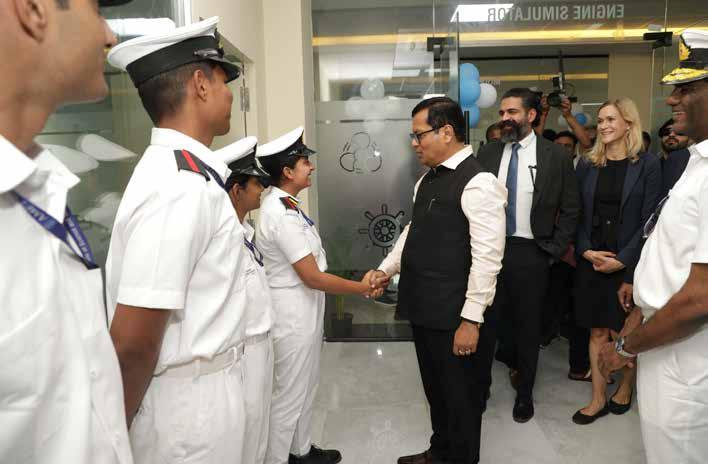
The Maritime Simulation Centre enables cadets to engage in realistic maritime scenarios within a controlled academic setting, significantly improving their skills before transitioning to real sea operations. Through highly authentic simulations, students will acquire exceptional practical experience and understand the complexities of modern maritime tasks, adhering to the high standards expected in the global maritime sector.
This inauguration further consolidates AMET’s reputation as India’s premier maritime education institution. It underscores the success of its strategic partnership with Maersk—a collaboration that continues to pioneer innovative educational models and shape the future of seafaring at both national and international levels.
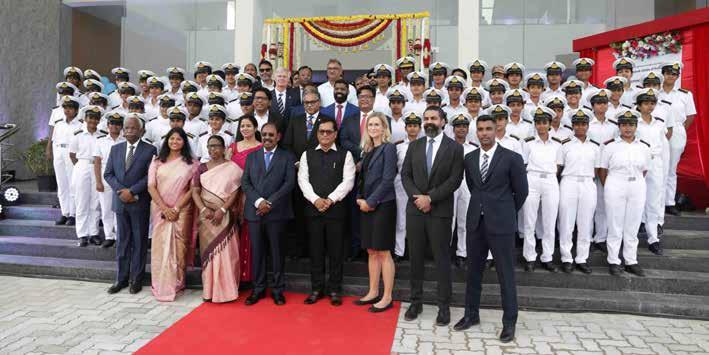
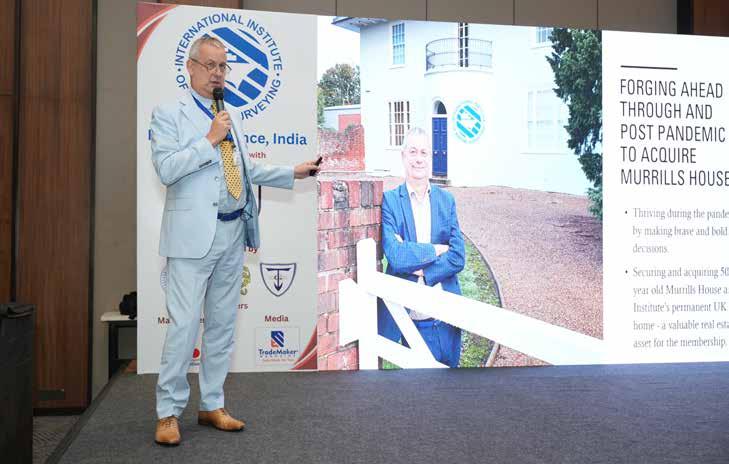
On September 7, 2025, The International Institute of Marine Surveying (IIMS) India Branch hosted its flagship conference, the IIMSIndia Conference 2025, at Fairfield by Marriott in Benaulim, Goa. The event brought together renowned speakers from the UK, UAE, and India to discuss pressing issues in the maritime industry, focusing on ethics, human skills, and cargo safety.
The conference was convened under the leadership of Capt. Ruchin C. Dayal, President of the IIMS and CEO of eDOT Solutions. Having an Indian at the helm of IIMS after more than a decade is a matter of great pride for the Nation’s maritime community, and Capt. Dayal’s presidency has brought renewed focus on the contribution of Indian surveyors to the global stage.
The conference commenced with Mr. Mike Schwarz, CEO of IIMS UK, delivering a keynote address on the role of IIMS in a rapidly changing maritime landscape. He emphasized the Institute’s commitment to maintaining global standards and raising professional benchmarks for surveyors. This was
followed by Capt. Zarir S. Irani’s thought-provoking talk on the ethics of marine surveying, highlighting the importance of integrity and responsibility in commercial surveying.
Capt. Shoukat Mukherjee, CEO of The Naval Connection, delivered an inspiring presentation on the importance of human skills in the age of automation and AI. He stressed that while technology is reshaping the shipping industry, human judgment, adaptability, and ethics remain essential.
A unique feature of the conference was the live quizzes that followed each presentation, testing the audience’s attentiveness and awarding prizes to the most engaged participants. The quizzes not only created a sense of excitement but also reinforced key lessons in a memorable way.
The conference also featured a role-play skit on the MV Bulk Jupiter liquefaction case, where delegates assumed various roles and debated liability, responsibility, and cargo safety. Additionally, Capt. Manish Kumar Dixit’s case study on bulk carrier operations provided valuable insights into the practical challenges of the industry.
A panel discussion on “The Next Surveyor – Respect, Responsibility, and Recognition” brought together industry experts to explore the challenges faced by surveyors and the competencies required for success. The debate was frank, lively,
and thought-provoking, highlighting the need for a renewed focus on professionalism and ethics in the industry.
The conference concluded with Mr. Mike Schwarz’s motivational session on “19 Tips for Business Success,” leaving delegates with valuable lessons applicable both at sea and ashore. Capt. Ruchin C. Dayal, President of IIMS and CEO of eDOT Solutions, expressed gratitude to the supporting organizations and acknowledged the dedication of the eDOT team in making the conference a success.
The IIMS-India Conference 2025 was hailed as a success, marking a step forward in elevating the role of surveyors in the maritime landscape. The event fostered collaboration, knowledge sharing, and a renewed commitment to professionalism and ethics in the industry.


GAC Shipping (India) Private Limited - Main office
GAC House, P.B. No. 515, Subramanian Road, Willingdon Island, Cochin 682 003, India
E: pricing.india@gac.com | T: +91 484 266 8372
CIN: U63090KL1983PTC003733
Bengaluru
Mr Gopala Krishna
T: +91 96863 55008
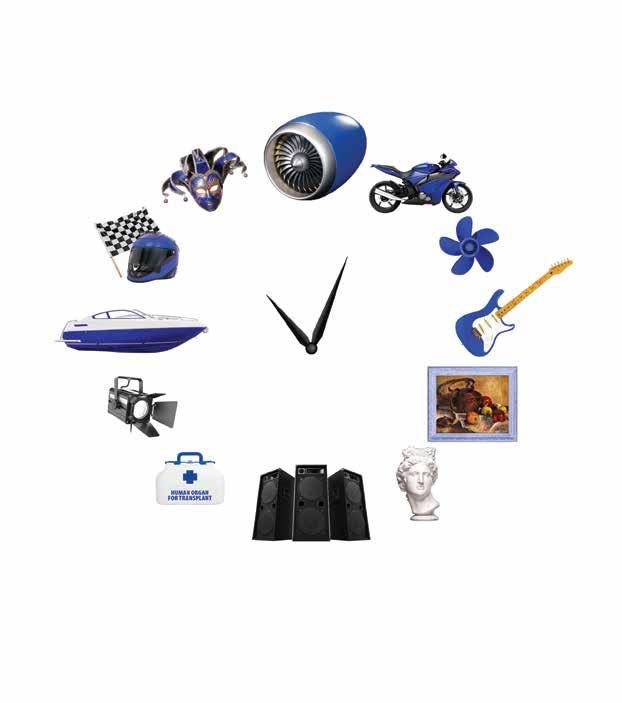
E: gopala.krishna@gac.com
Chennai
Ms Ranjani Kumar
T: +91 98846 62852
E: ranjani.kumar@gac.com
Cochin
Mr Swaraj Joseph T: +91 79943 33270
E: swaraj.joseph@gac.com
Delhi
Mr Jaya Shekar T: +91 98992 05424
Kandla
Mr Jatin Joshi T: +91 98251 58583, E: jatin.joshi@gac.com
Kolkata
Mr Dipayan Hore T: +91 99036 27997
E: jaya.shekar@gac.com gacshippingindia
E: dipayan.hore@gac.com
Mumbai
Mr Sanket Chandwade
T: +91 83697 44069
E: sanket.chandwade@gac.com
Pune
Mr Arjun Bangar
T: +91 98196 69622
E: arjun.bangar@gac.com
